Throughout the history, Thailand, formerly Siam, had four “native” kingdoms, in the sense that its territory was not under the rule of other foreign conquerors like the Khmer Kingdom that expanded from the east or the Burmese Empire that approached from the west. Today, in the early 21st century, the reigning monarch belongs to the Chakri dynasty, established in 1782 by King Rama I under the name of Rattanakosin Kingdom. Since 1939, it has been referred to as the Kingdom of Thailand. Before that, the third kingdom, Thonburi, lasted very briefly from 1767 to 1782, founded by King Taksin the Great after the fall of Ayutthaya Kingdom and the reunification of the state. It was precisely Ayutthaya Kingdom that was the second kingdom, which existed from 1351 to 1767. I visited the remnants of ancient Ayutthaya at the beginning of my journey through Thailand from mid-February to mid-March 2023, and the first part of the story about that visit begins in https://www.svudapodji.com/en/thailand-10/.
And before Ayutthaya, there was the first indigenous kingdom, the Kingdom of Sukhothai, which lasted independently from 1238 to 1351. Often, the year 1351 is used to mark the end of this kingdom since it was in this year that the capital of the second kingdom, Ayutthaya, was founded. The Kingdom of Sukhothai continued to exist as a vassal state (more precisely, a tributary state) until 1438.
The capital of this kingdom until 1347 was the city of Sukhothai that is also the name of a smaller contemporary town located about 12 km east of the remains of the ancient capital and approximately 450 km north of Bangkok.
It was precisely these remnants of the historical city of Sukhothai that I came to visit.
After my morning coffee in the room, I got ready and went out to the main street with the intention of hailing a tuk-tuk. Since I wasn’t able to do that right away, I paid attention to my surroundings. I noticed a woman at her workplace with a sewing machine and it was more open than being in a store window. I just couldn’t figure out why a tailor was working in a shop with car spare parts and motor oils.
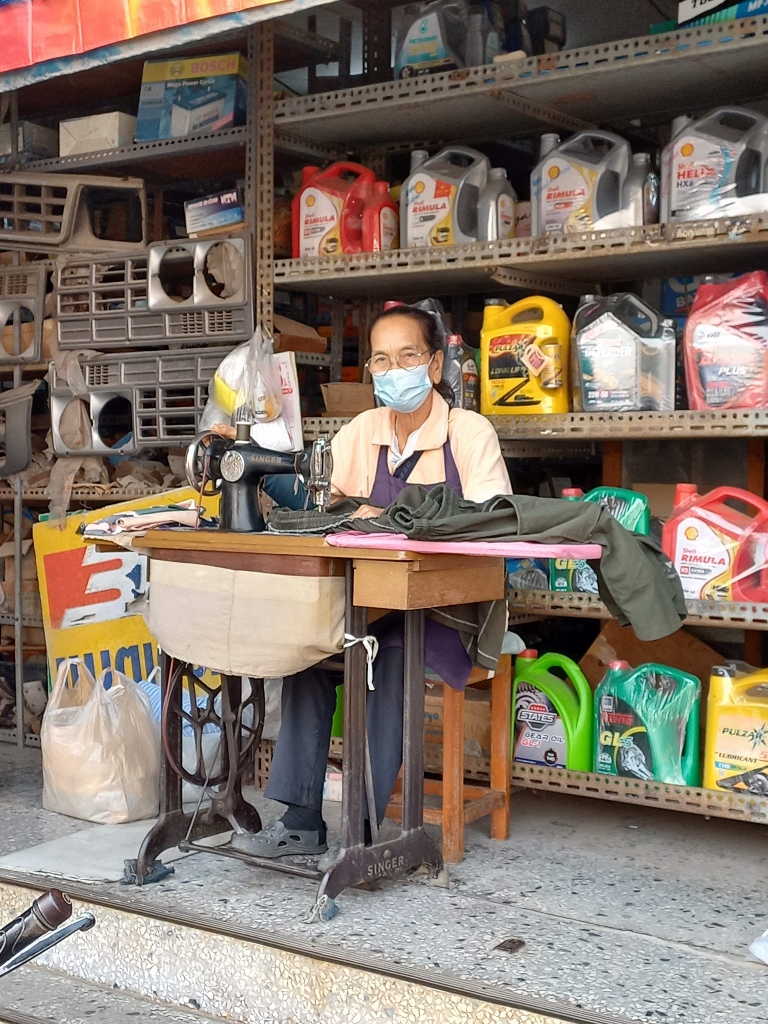 Contemporary Sukhothai, a detail
Contemporary Sukhothai, a detail
Still, soon enough a tuk-tuk picked me up.
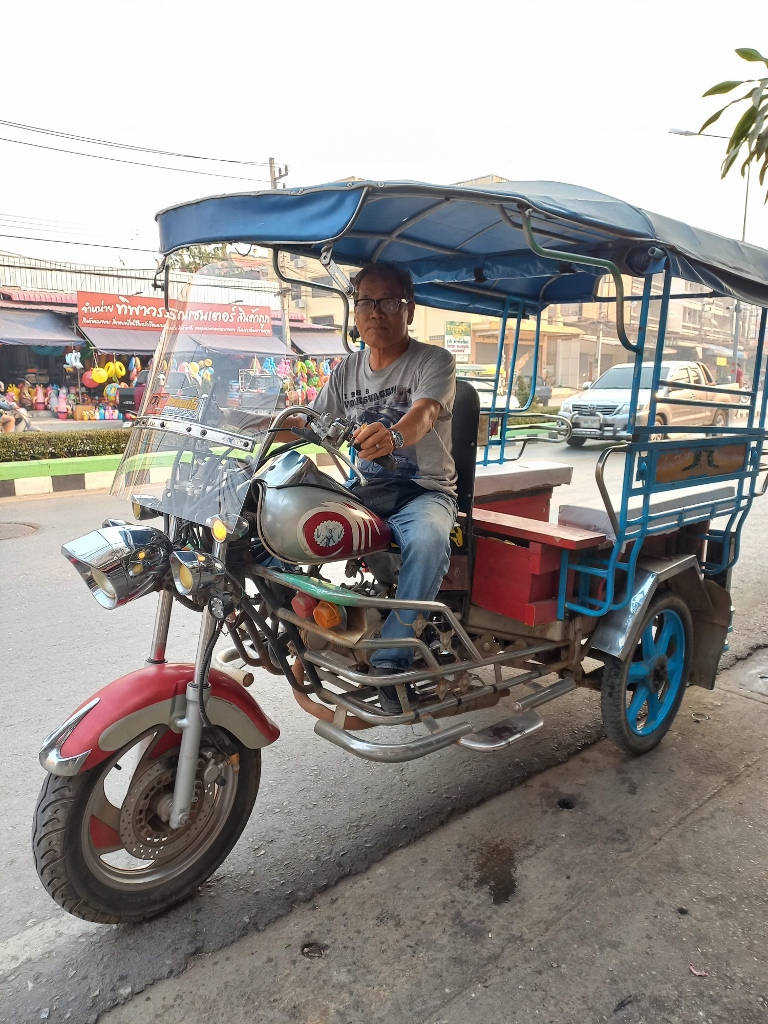 Tuk-tuk in Sukhothai, a detail
Tuk-tuk in Sukhothai, a detail
We agreed on the price and set off. When I say “agreed on the price,” it means that I first told him where I was going, he confirmed it, then I asked “How much?,” he then quoted a price that was very high by local standards, but realistically, it usually isn't too high. However, from experience, I know never to agree to that price. Instead, I propose a lower one, say half, which is still more than what locals pay. However, I’m normally not too concerned about what locals pay for anything. Then we negotiate a bit more and usually settle on a price in the middle, meaning both sides are pleased.
From time to time, I come across comments from foreigners on the internet, usually from Western Europe or the USA, who are bothered by the existence of two pricing systems in countries like Thailand – one for the local population and another for foreign tourists. I genuinely don’t understand what the problem is. I don’t come from a highly developed and wealthy country, but I have a good profession and I am excellent at what I do. However, even though I earn well for Serbian standards, it is nowhere near what my colleagues in Western Europe and the USA earn. Yet, when I travel, whether to countries like Thailand or the West, I simply see how much money I have and what I can do with that money, without bothering about how much the local population earns or pays for anything. People who criticise such things are primarily stingy; when they come to countries like Thailand, where everything is already cheaper than in the West, they want to pay even less than what locals pay. Comments are usually about different ticket prices for numerous historical and archaeological sites, museums and temples, as it is clearly stated on the tickets. Instead of concerning themselves with whether they pay 2-3 euros or dollars for a ticket to some often profoundly important place, not half a euro or dollar, like the local residents, they should first lower their ego and not think that someone has increased the price just to “fleece” them. They should consider that it’s a reduction of the real price for the local population and that it might be the only way to give them the opportunity to afford to come and visit important places that represent primarily their nation’s heritage. Secondly, if they dislike local customs, including the two-tier pricing system, they can stay in their countries where they will pay entrance fees to museums and various sites from 20 euros or dollars and up. And they can be happy.
But, to get back to my sightseeing around Thailand.
So, I took a tuk-tuk to the Sukhothai Historical Park and the driver dropped me off right next to one of the numerous agencies renting bicycles. I enjoy walking, but the Sukhothai Historical Park is enormous! On foot, you can maybe cover the central part and even that is challenging. However, to see anything else worth exploring, some form of transportation must be used. Admittedly, it’s possible to rent small motorcycles or electric vehicles, like golf carts. For the central part of the site, there are larger electric vehicles that stop at specific stations where visitors can freely get off and later board the next vehicle of that type that comes along.
I didn’t use any of that; instead, I opted for a bicycle. Renting was around 0.80 euros for the whole day (30 baht) and the bicycle was in line with that. It was quite a wreck! Especially noticeable later when I got tired and the temperature rose to 34°C (in the shade)! But initially, the ride was quite enjoyable, except that I had to stop relatively often to take photos. It’s much easier when you’re on foot and don’t need to dismount a bicycle.
The Sukhothai Historical Park is an exceptionally large site and it surely takes days to explore everything here. To facilitate navigation, the site is divided into several zones: the Central or the inner city and four zones of outer areas divided by cardinal directions. I started from the centre of the Central zone.
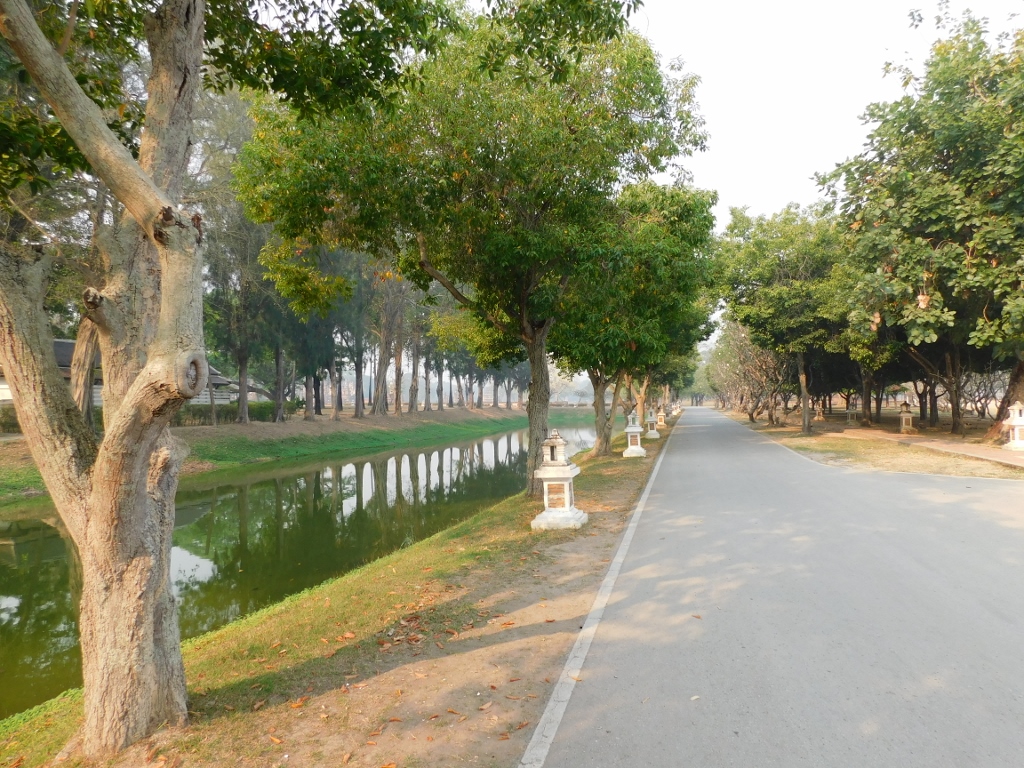 Sukhothai Historical Park, the beginning of the site
Sukhothai Historical Park, the beginning of the site
 Sukhothai Historical Park, the outline of the first temple
Sukhothai Historical Park, the outline of the first temple
Right from the start, it occurred to me that I might make it easier for myself to take photos by shooting a video while riding the bicycle. As a memory of those moments, this turned out well, but it’s quite clear that I suck at riding a bicycle and filming at the same time. It rarely crossed my mind to repeat this.
That’s why I rode the bicycle to the entrance of the first temple area, parked it and then took a short walk along the outer path in order to observe and film parts of the temple complex from there.
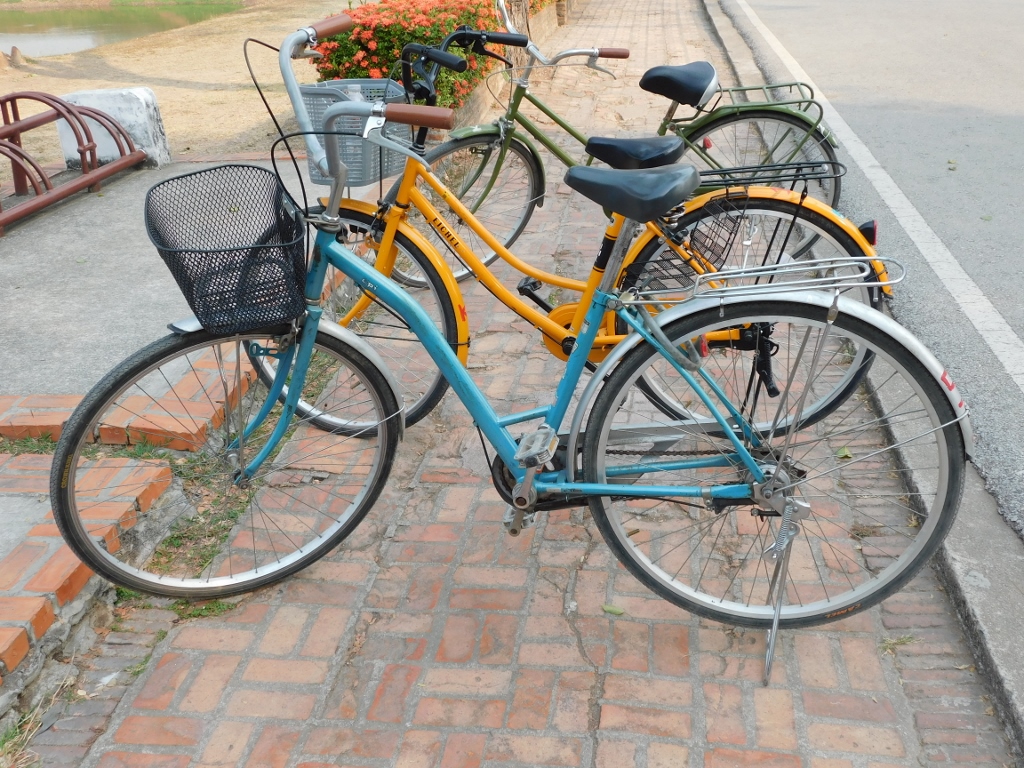 My bicycle is blue
My bicycle is blue
 Sukhothai Historical Park, Wat Mahathat temple
Sukhothai Historical Park, Wat Mahathat temple
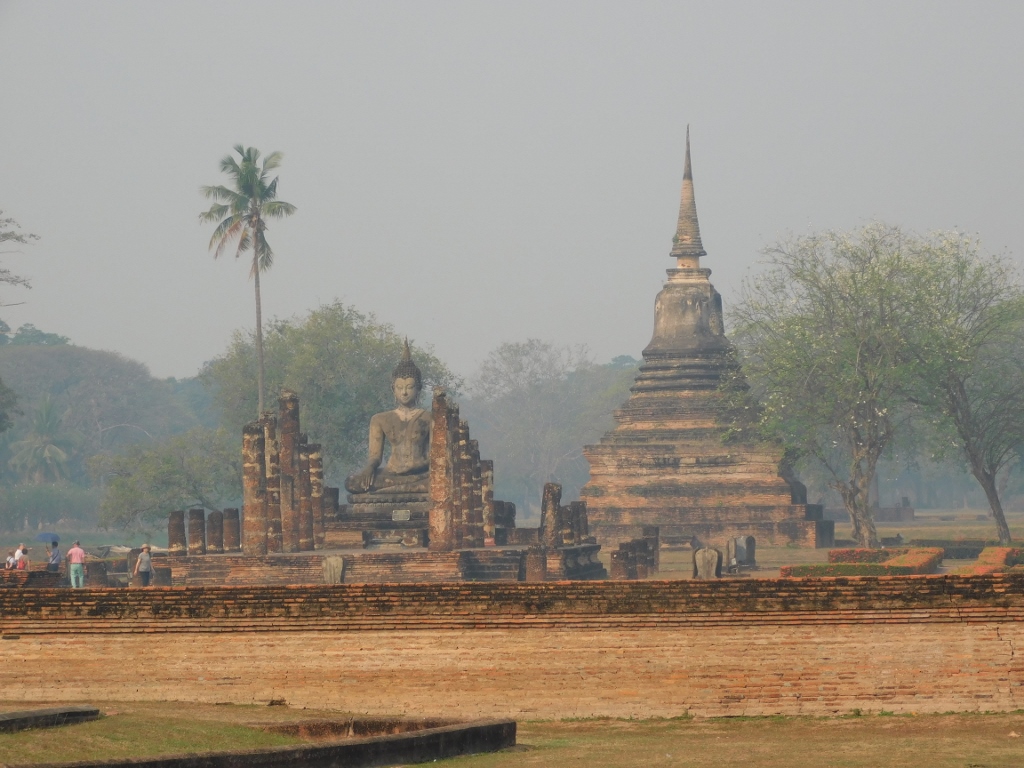 Wat Mahathat, details seen from the street
Wat Mahathat, details seen from the street
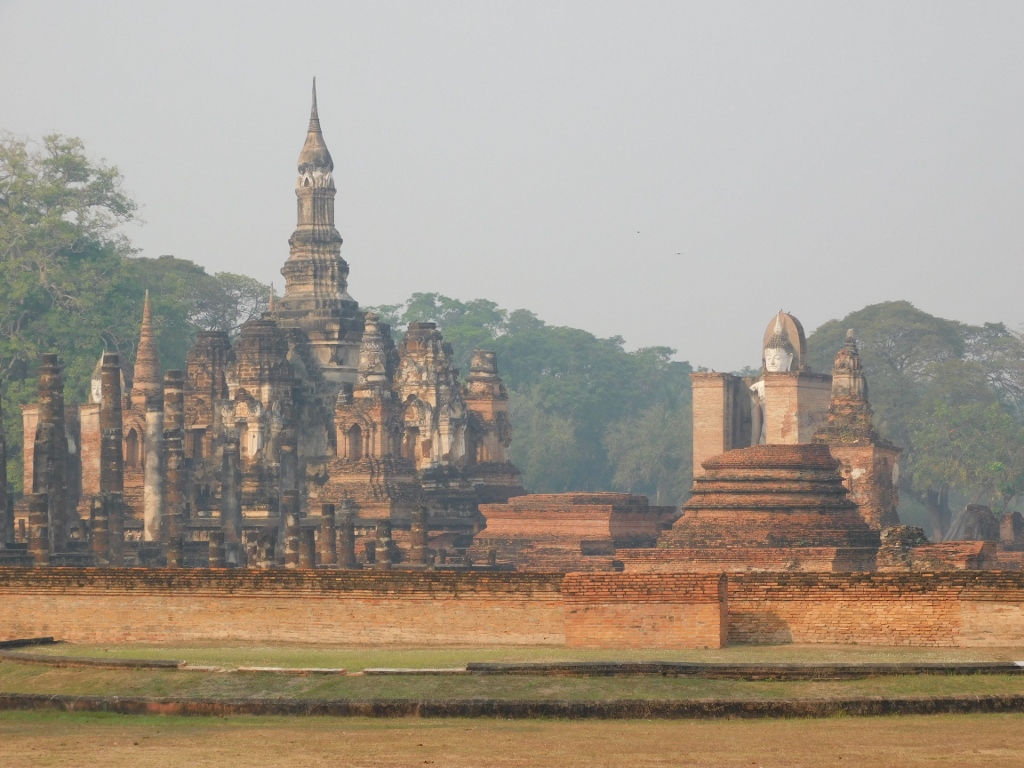 Wat Mahathat, details seen from the street
Wat Mahathat, details seen from the street
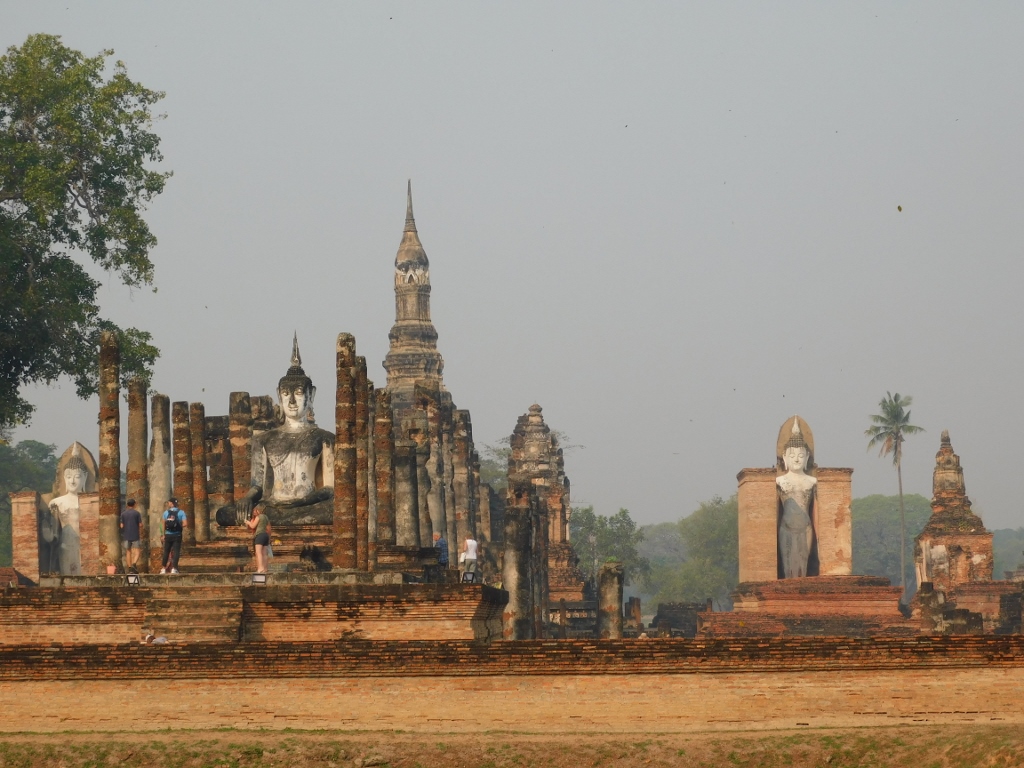 Wat Mahathat, details seen from the street
Wat Mahathat, details seen from the street
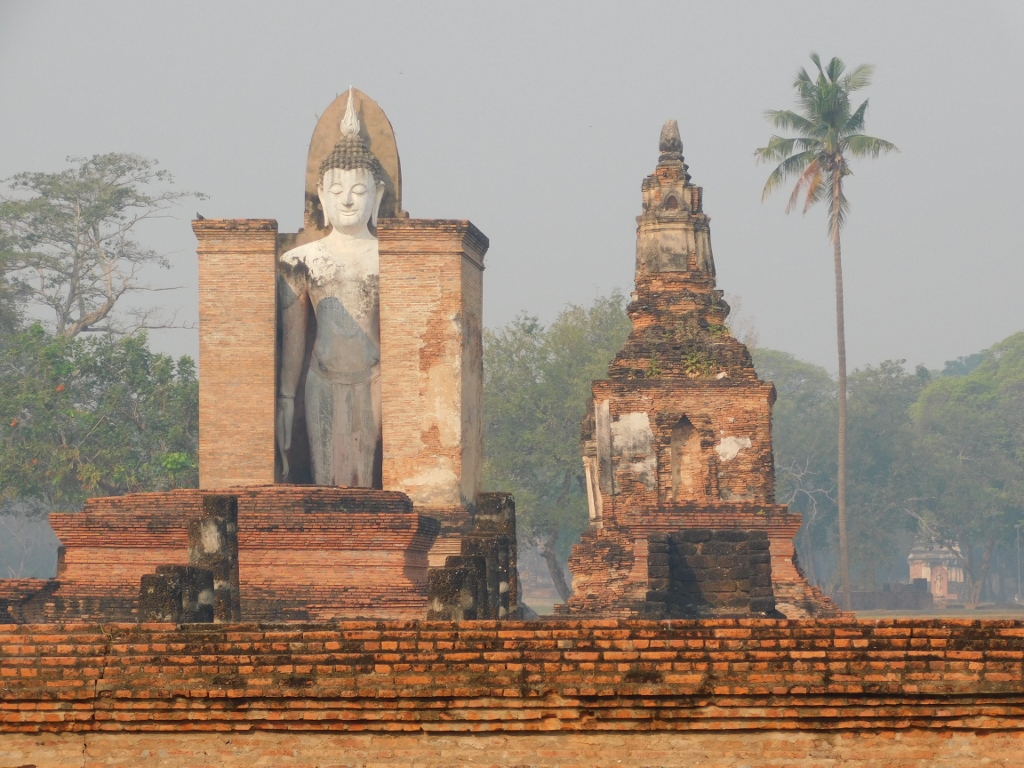 Wat Mahathat, details seen from the street
Wat Mahathat, details seen from the street
By the way, I arrived here at 9:15 in the morning and it’s worth noting the mist that is clearly visible in the photos. This promised high humidity, which, combined with the high temperature, creates challenging conditions for sightseeing. On the other hand, the beauty of the place was enticing, so I boldly proceeded.
The Wat Mahathat temple was built in the 13th century and was located in the heart of the capital of the Kingdom of Sukhothai. It was the main and therefore the most important temple in the city. The temple or, more precisely, the temple complex has an almost regular square plan (about 200 x 200 m) surrounded by a brick wall. There is a moat with water around the brick wall, symbolising the cosmic ocean.
Within the wall, you can find the main chedi (the Thai term used instead of stupa), the main vihara and several smaller viharas, 3 mondops (Thai word for mandapa), ubosot and about 200 smaller chedis. By the way, I’ve already explained these terms earlier, so I won’t do it again now.
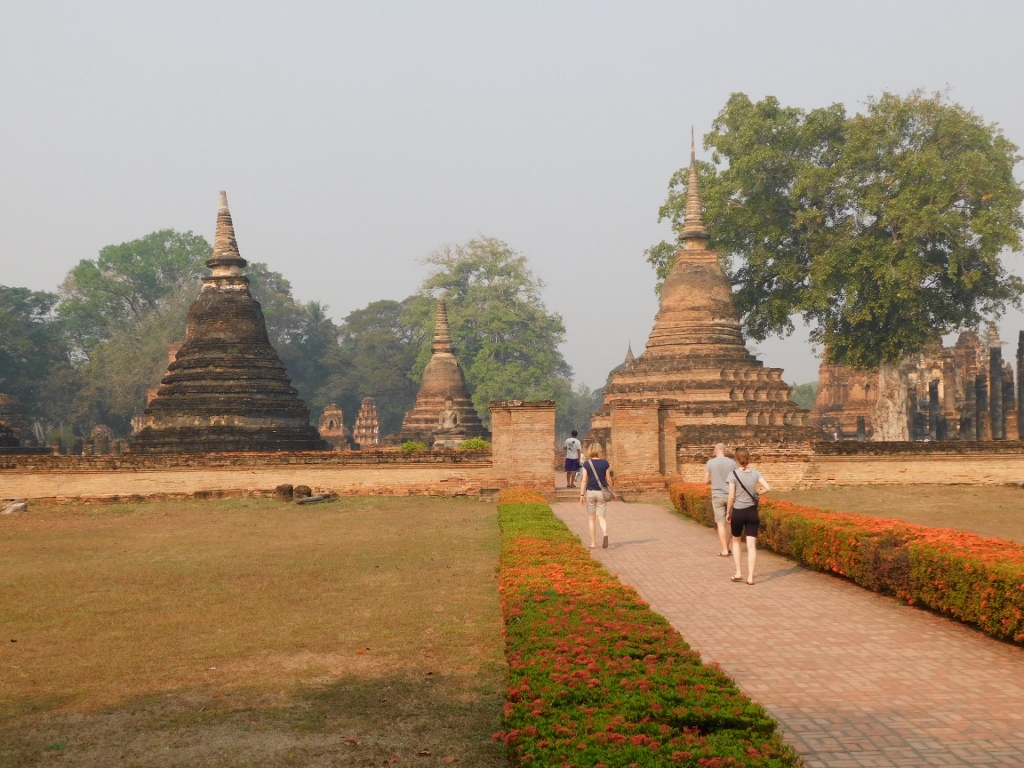 Wat Mahathat, access to the temple
Wat Mahathat, access to the temple
 Wat Mahathat, access to the temple
Wat Mahathat, access to the temple
The path that guides visitors into the temple area leads to the part of the complex south of the main chedi and I decided to visit the chedis and Buddha statues I encountered in that area first.
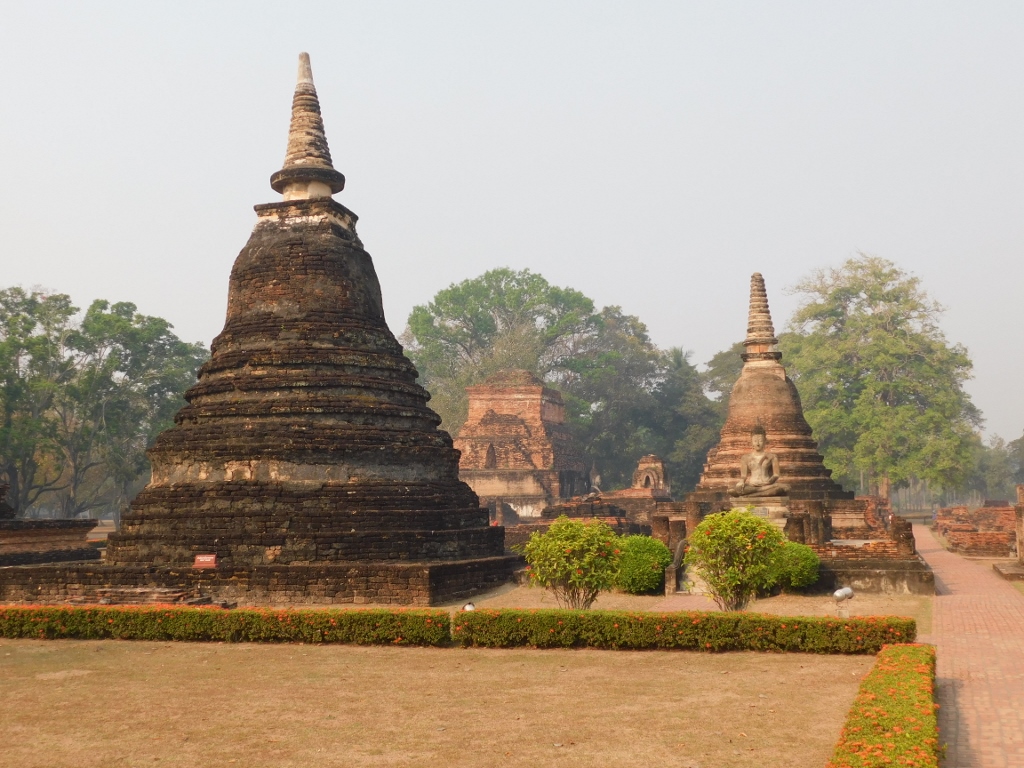 Wat Mahathat, a detail
Wat Mahathat, a detail
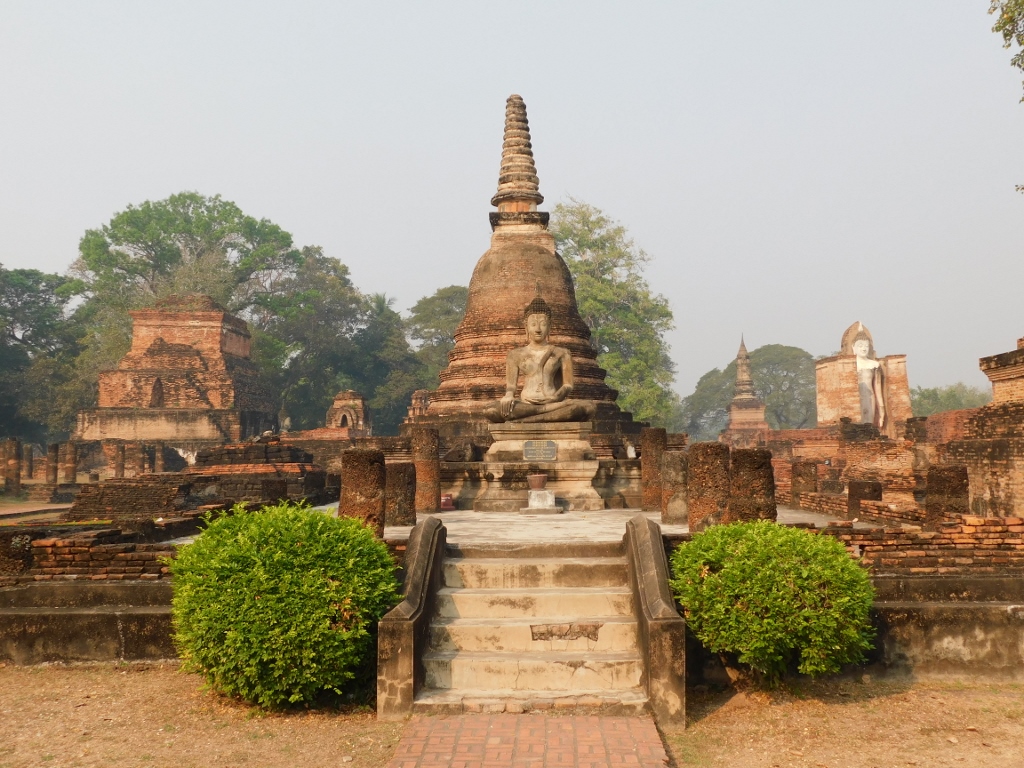 Wat Mahathat, a detail
Wat Mahathat, a detail
I don’t have any special or important information for most of the structures that can be seen here, but that doesn’t diminish the enjoyment of the site in the least. There are numerous not only structures within the temple. but also details on almost every one of them. I believe that, in the end, for someone who is not a Buddhist or an art historian, information about these details is not very crucial. One just needs to surrender to the experience and perhaps play with photography, as I did.
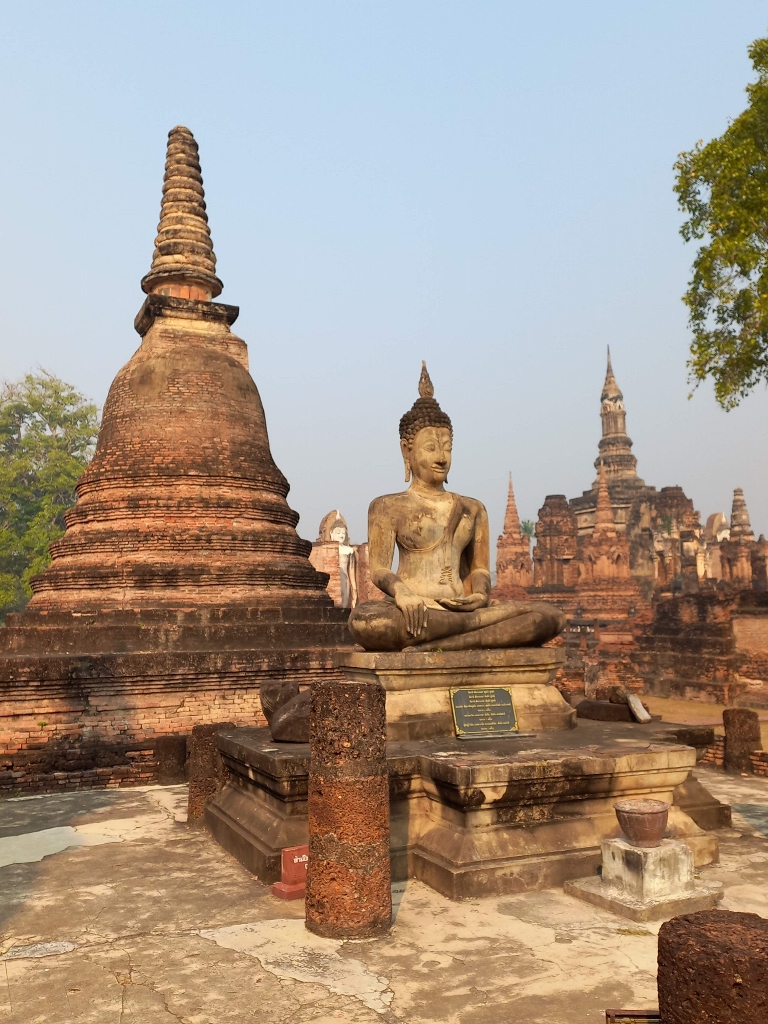 Wat Mahathat, a detail
Wat Mahathat, a detail
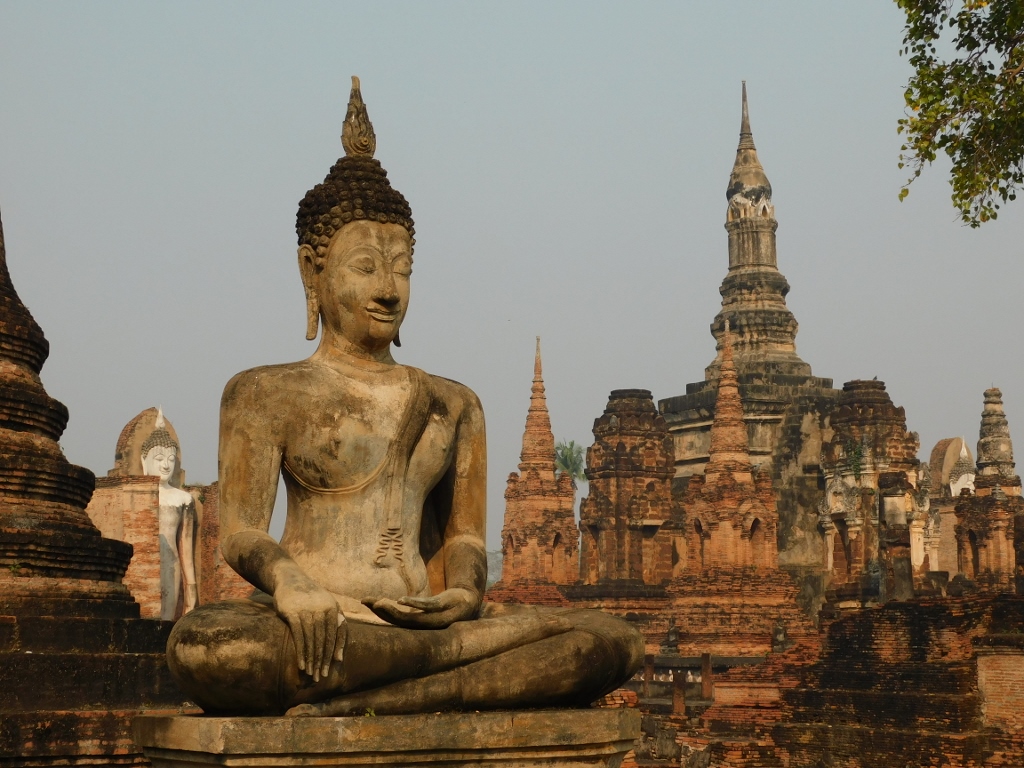 Wat Mahathat, a detail
Wat Mahathat, a detail
 Wat Mahathat, a detail
Wat Mahathat, a detail
After this brief exploration of the structures south of the main chedi, I decided to return to the main path and head towards the main mondop.
 Wat Mahathat, the front of the south structures is to the left, while the main mondop is to the right
Wat Mahathat, the front of the south structures is to the left, while the main mondop is to the right
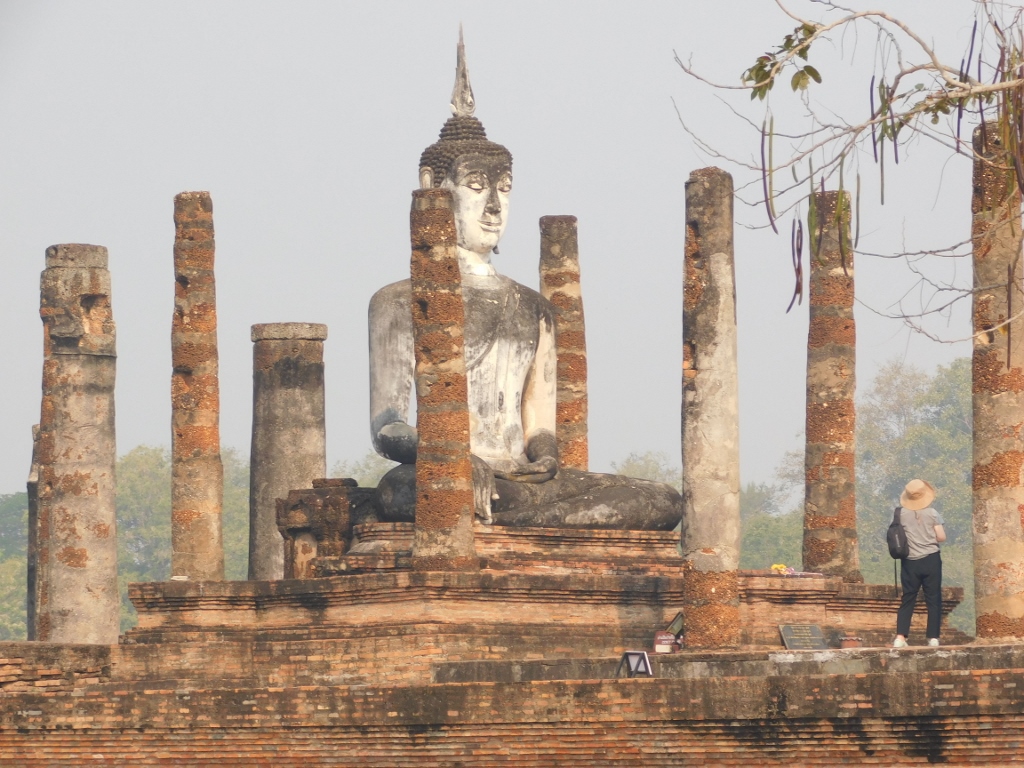 Wat Mahathat, main mondop
Wat Mahathat, main mondop
Along the way, from a distance, I admired some other details of the group of structures south of the main chedi and the path also leads past a beautifully restored chedi with a polyangular base.
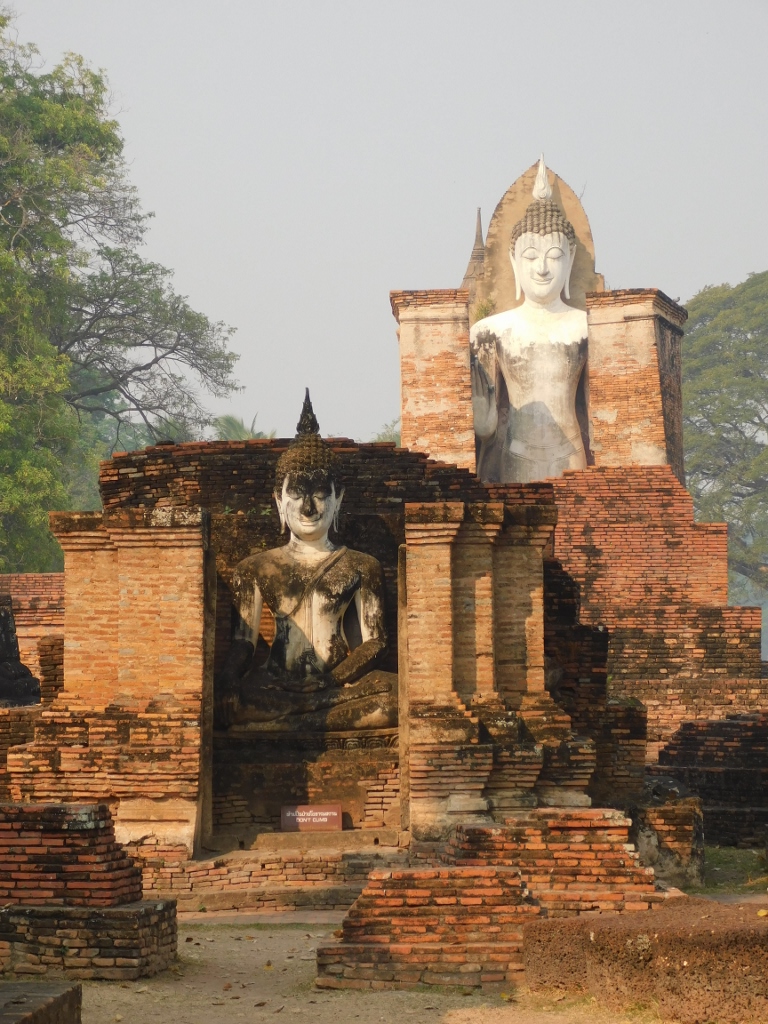 Wat Mahathat, a detail
Wat Mahathat, a detail
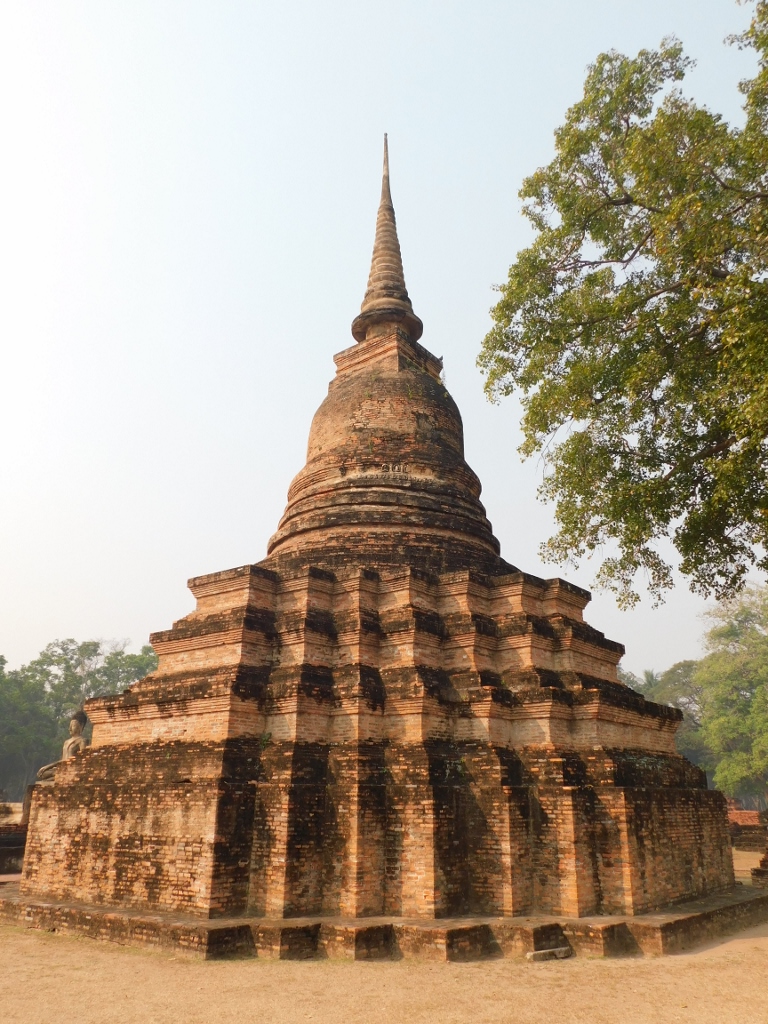 Wat Mahathat, a detail
Wat Mahathat, a detail
On this chedi, it was interesting to see the modest remains of the stucco-style decoration.
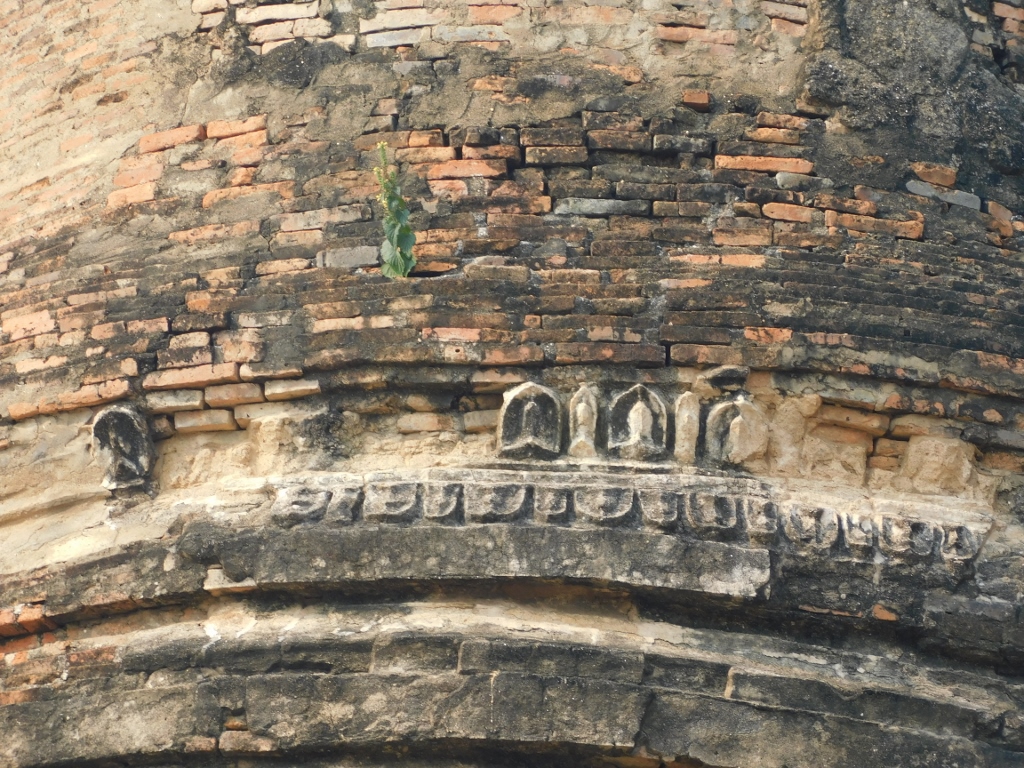 Wat Mahathat, a detail
Wat Mahathat, a detail
Then I walked along the path on the side of the main mondop, reaching the front entrance and climbing onto the platform at the bottom, where there is a large seated Buddha figure done in the stucco technique.
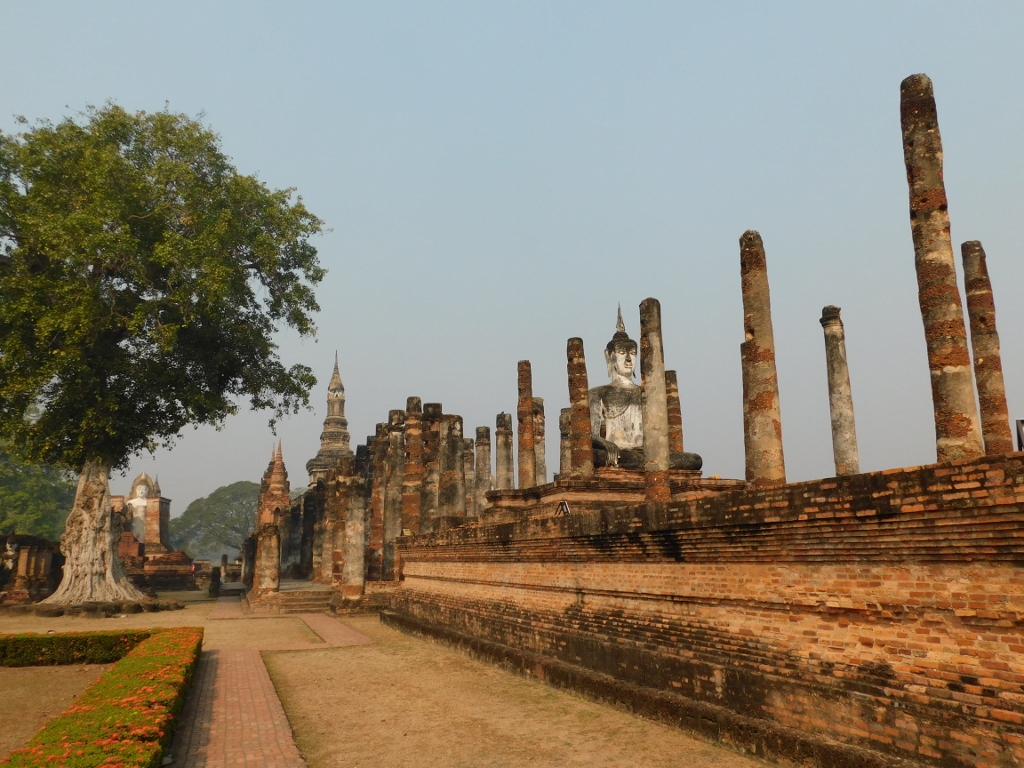 Wat Mahathat, a detail
Wat Mahathat, a detail
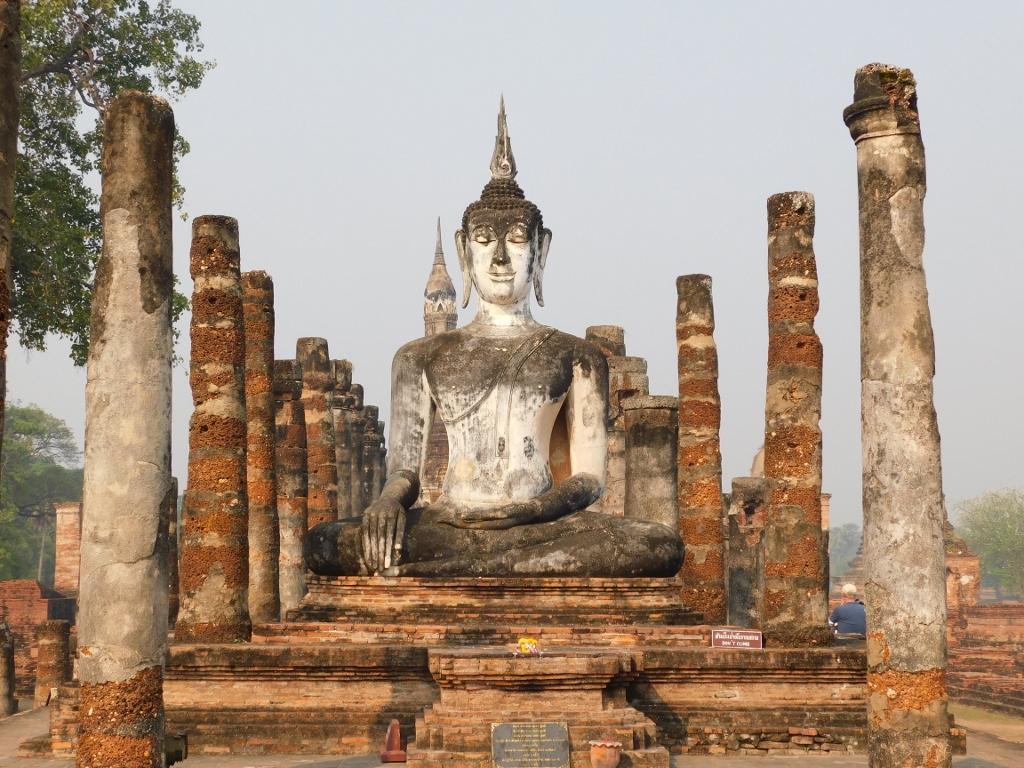 Wat Mahathat, a detail
Wat Mahathat, a detail
From the platform, there is also a beautiful view of the parts north of the main axis, which includes the main mondop, the main vihara and the main chedi, along with the remains of smaller viharas and chedis, leading to the ubosot that I visited later on.
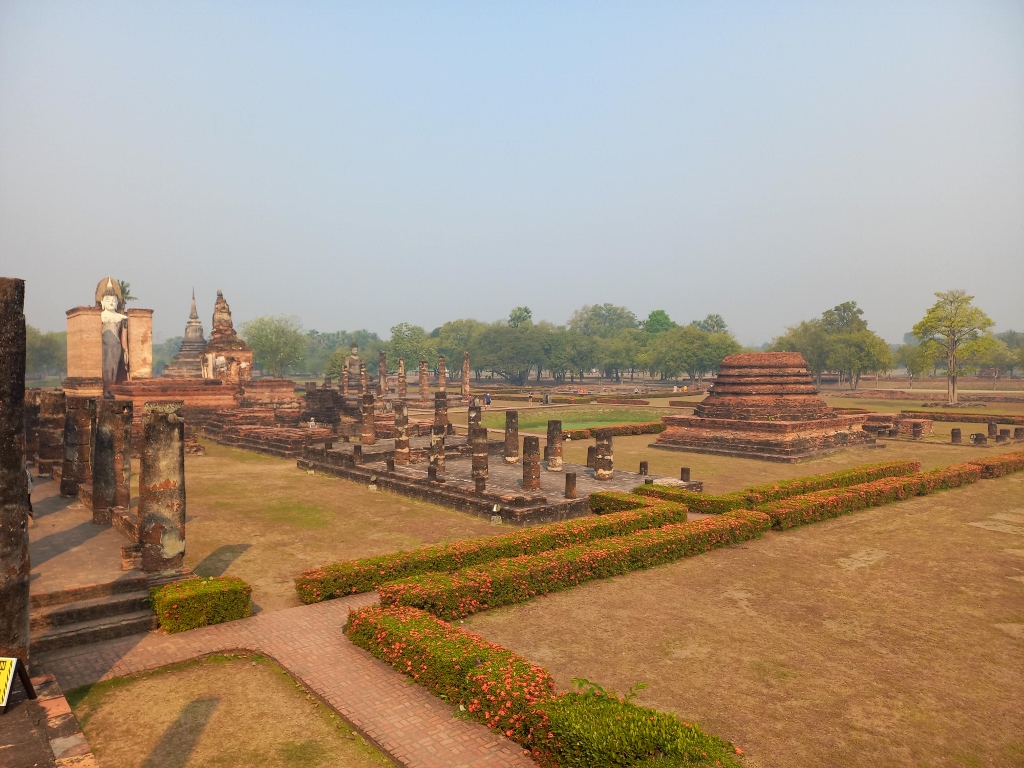 Wat Mahathat, north section of the temple
Wat Mahathat, north section of the temple
I also had a nice view from this platform of the remains of the main vihara and, a bit further, the main chedi.
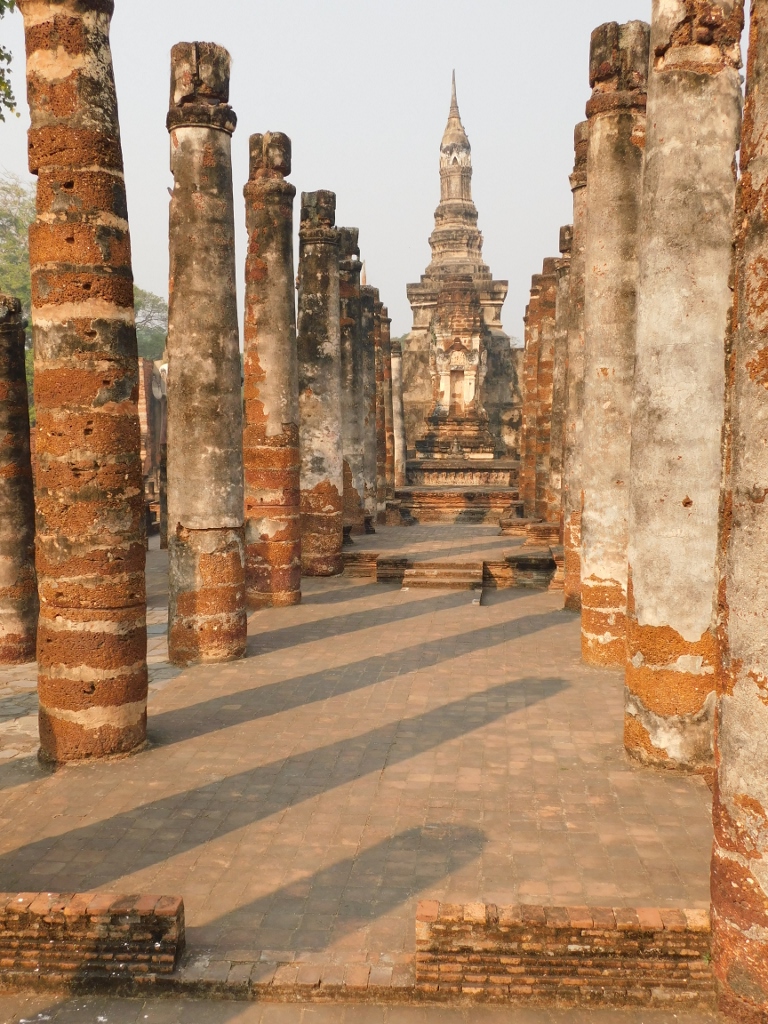 Wat Mahathat, a detail
Wat Mahathat, a detail
When I descended from the mondop and went to the main vihara, I found it interesting to take a photo of the previously seen statue of Buddha from the back. Then, I also paid attention to the base at the bottom of the vihara.
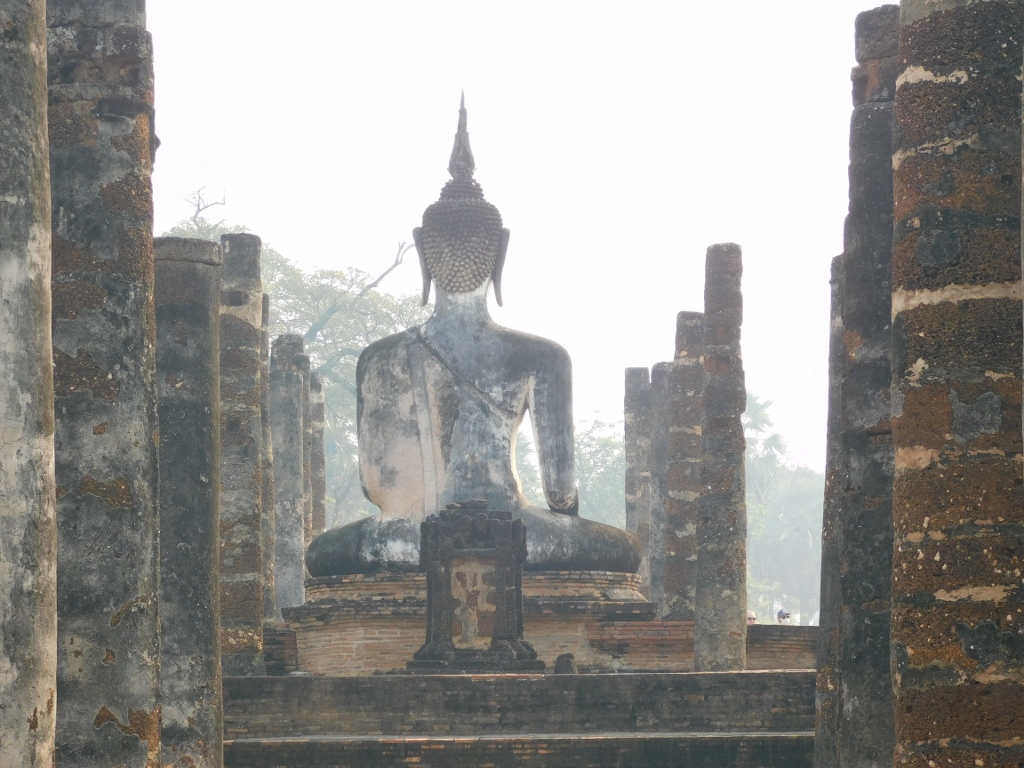 Wat Mahathat, a detail
Wat Mahathat, a detail
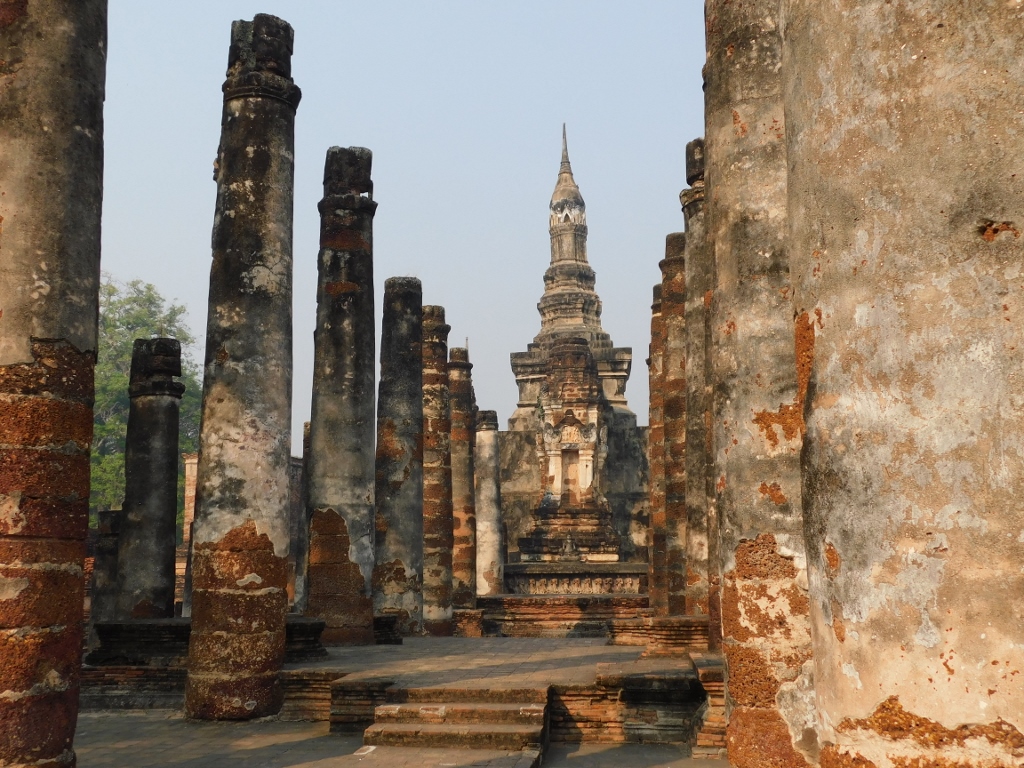 Wat Mahathat, a detail
Wat Mahathat, a detail
Namely, here in the main vihara of Wat Mahathat, filled with the remains of numerous tall pillars, there used to be an 8-meter-high Buddha statue. It is the largest bronze Buddha statue in Thailand from the Sukhothai period, cast in the 14th century (installed in the vihara in 1362). In the late 18th century, King Rama I moved this statue to Wat Suthat temple in Bangkok, where it received the name of Phra Si Sakayamuni. You can see that statue in https://www.svudapodji.com/en/thailand-6/.
From the vihara’s platform, I had a clear view of the main chedi, built in 1345, and its details.
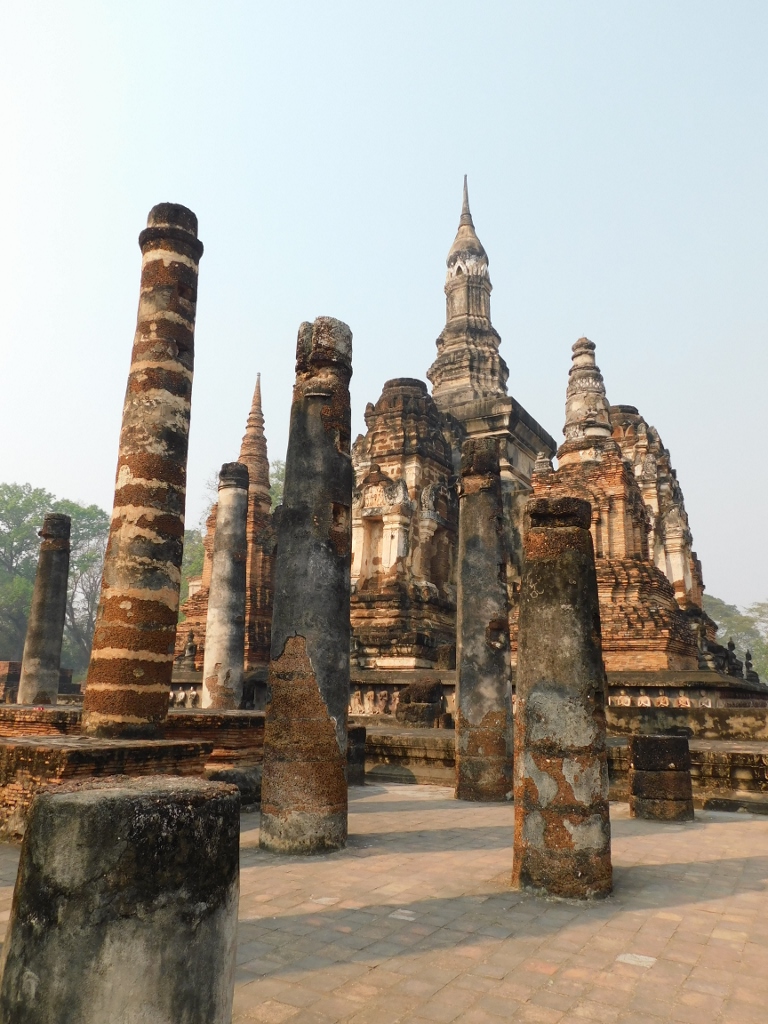 Wat Mahathat, view at the main chedi
Wat Mahathat, view at the main chedi
Around the main chedi, there are 8 smaller chedis, with four at the corners designed in a style originating from the Lan Na kingdom in northern Thailand. The chedis between these at the corners, oriented towards the cardinal points, are shaped like prasats, following Khmer models.
In the photo below, you can see the top of the eastern prasat-shaped chedi, the central spire of the main chedi, the pillar from the main vihara and the top of the northeast chedi. Each of these elements is interesting in its own way.
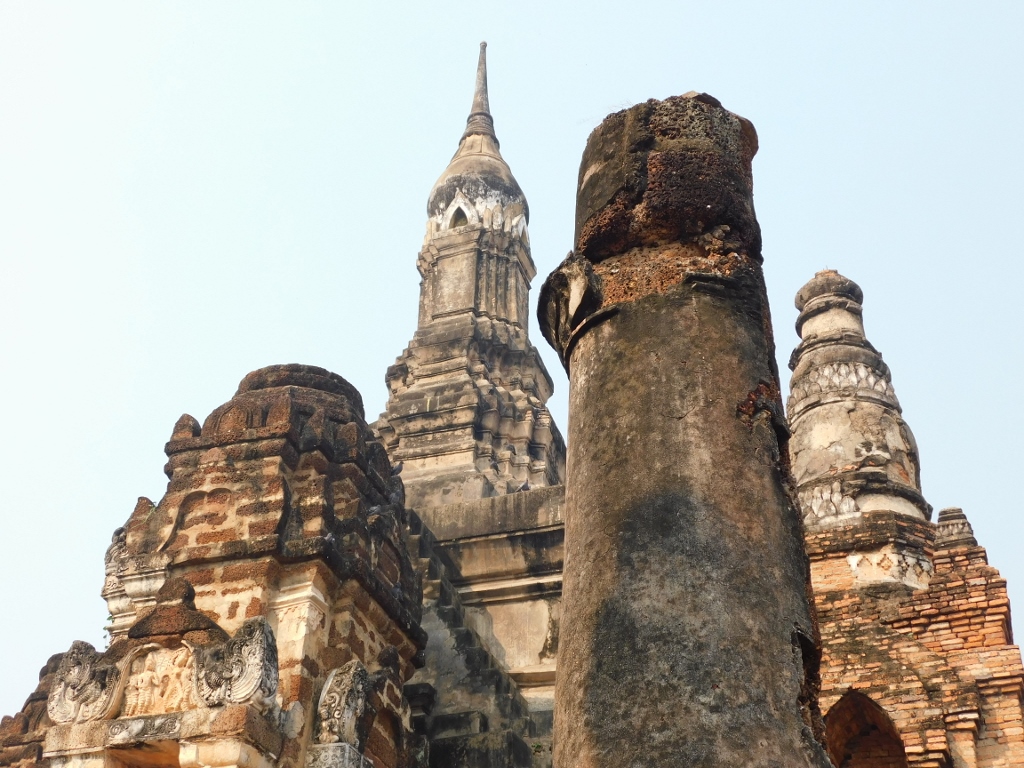 Wat Mahathat, a detail
Wat Mahathat, a detail
For instance, in the picture of the chedi built at the northeast corner, besides the Buddha statue, you can see a stucco relief depicting Buddhist disciples or pilgrims walking with their hands clasped together in prayer. This frieze completely surrounds the base of the main chedi and is not part of the corner chedi.
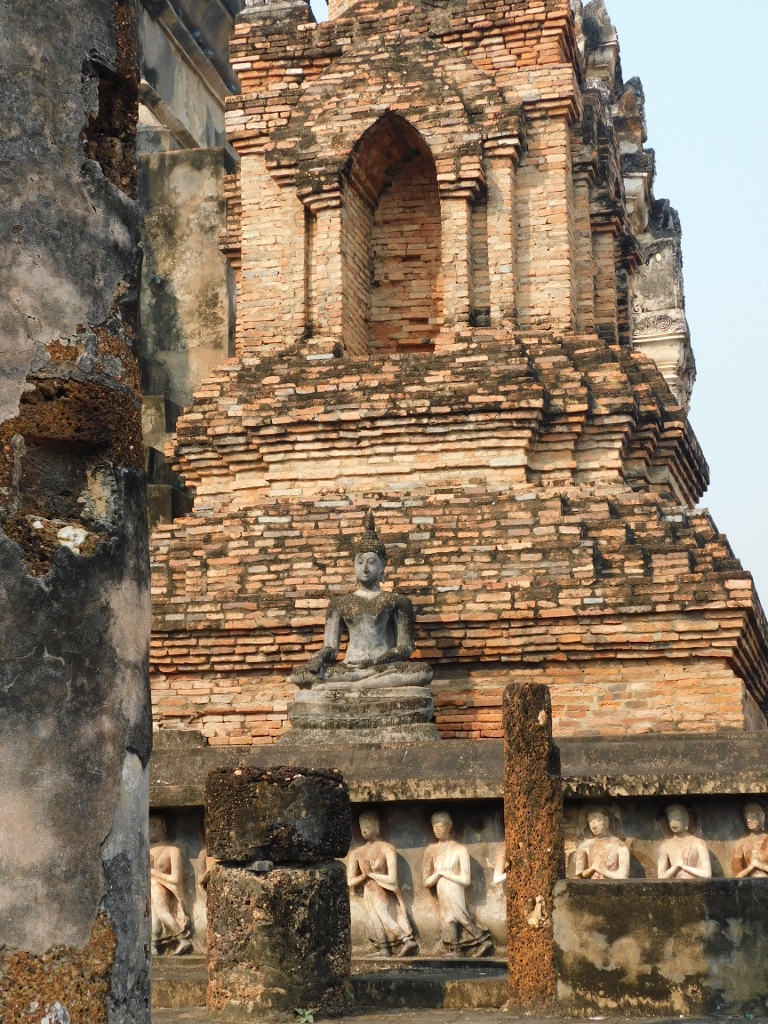 Wat Mahathat, a detail
Wat Mahathat, a detail
On the eastern prasat, the details of the surviving decoration are wonderfully visible. To begin with, I captured the eastern side of the prasat and, later, its southern side. Here are both photos right away.
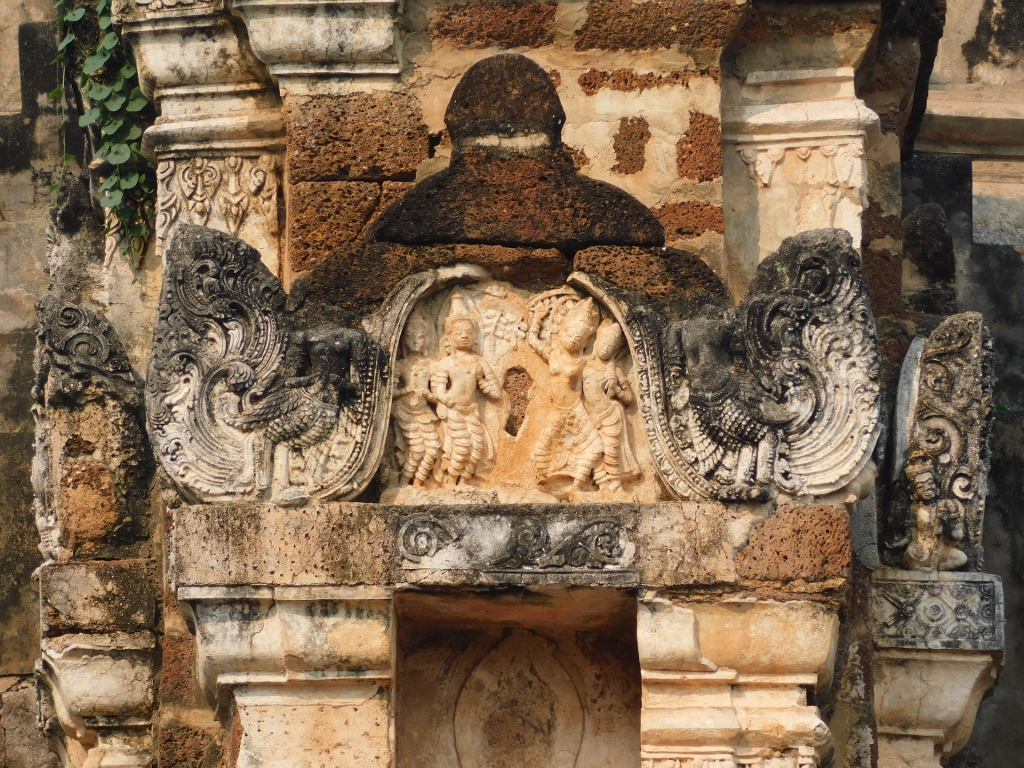 Wat Mahathat, a detail
Wat Mahathat, a detail
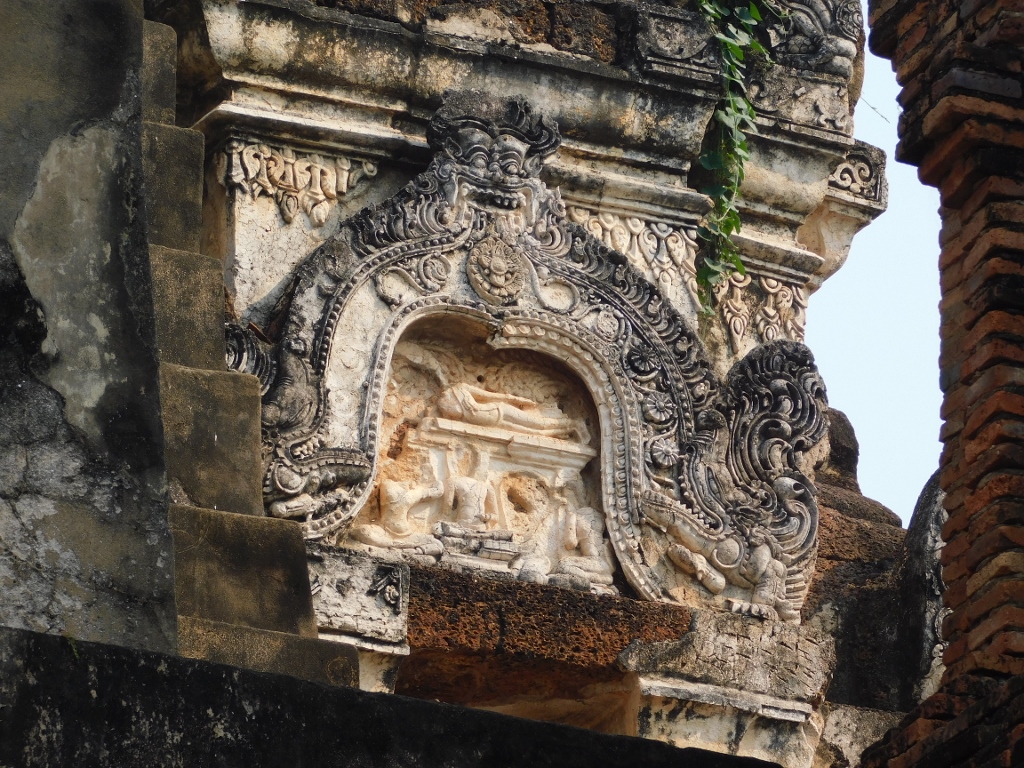 Wat Mahathat, a detail
Wat Mahathat, a detail
Still, perhaps the most interesting detail is the top of the main chedi, decorated with an elegant finial in the shape of a lotus bud, representing one of the characteristics of Sukhothai art.
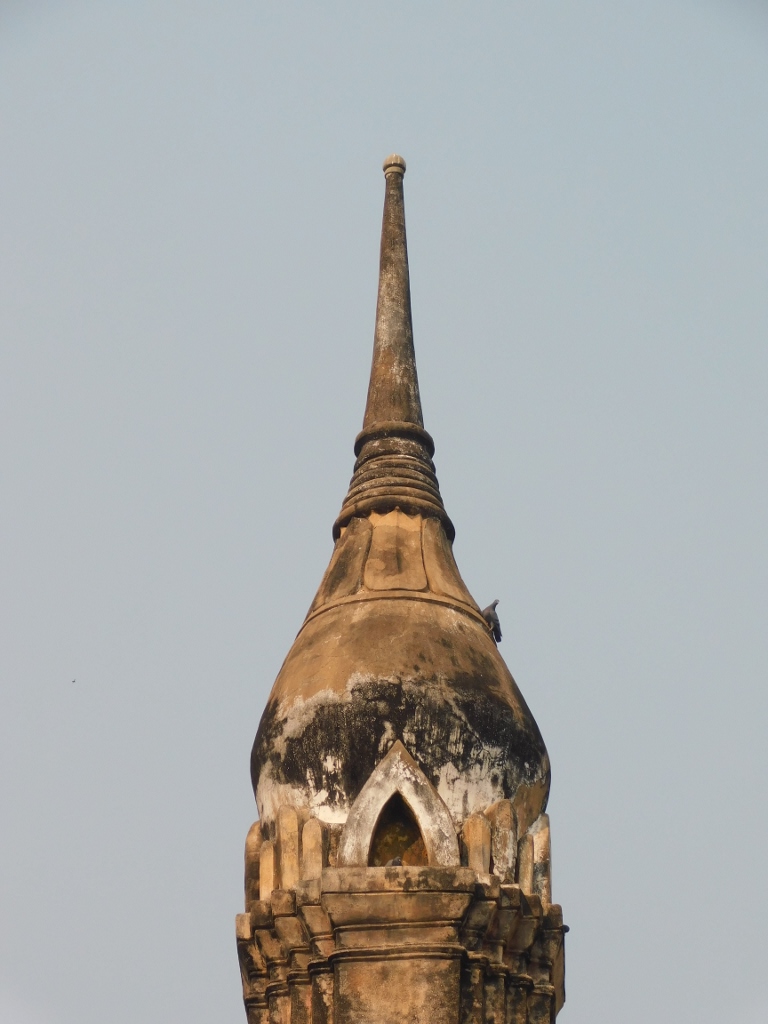 Wat Mahathat, a detail
Wat Mahathat, a detail
Now I started to stroll around the temple complex, but once again, I took a photo of the main chedi and its smaller chedis done in two different styles. The image also shows the frieze of pilgrims in prayer.
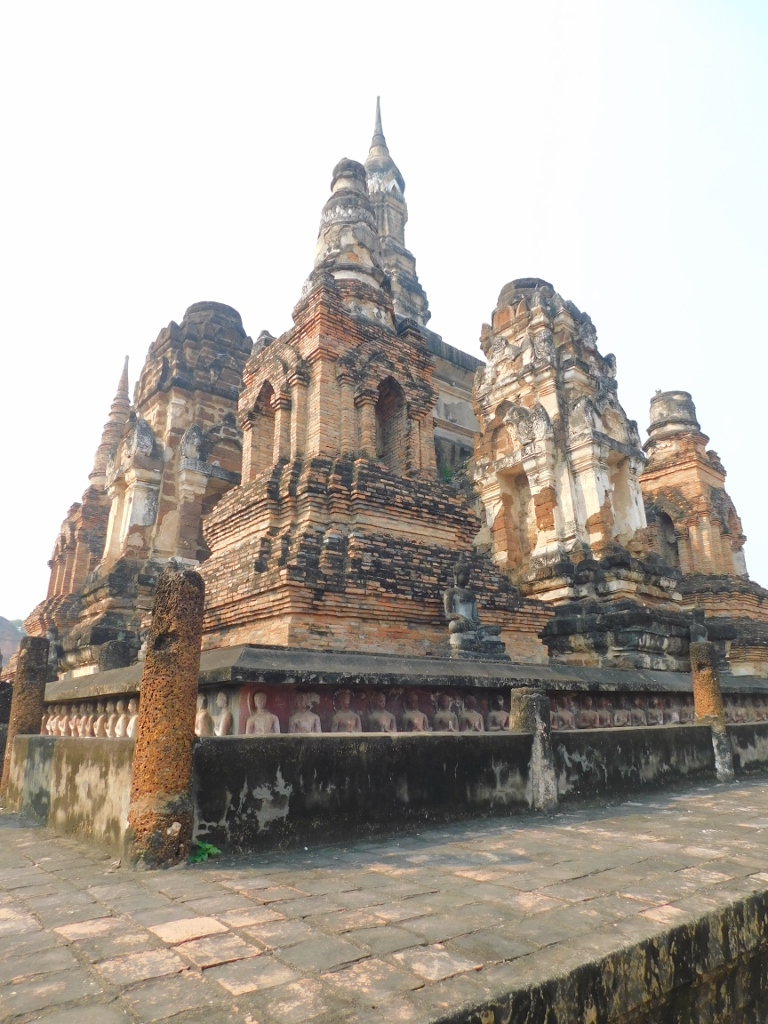 Wat Mahathat, main chedi
Wat Mahathat, main chedi
North and south of the main chedi, there are mondops housing standing Buddha figures, each 9 meters tall and surrounded by walls. First, I went to the one on the northern side.
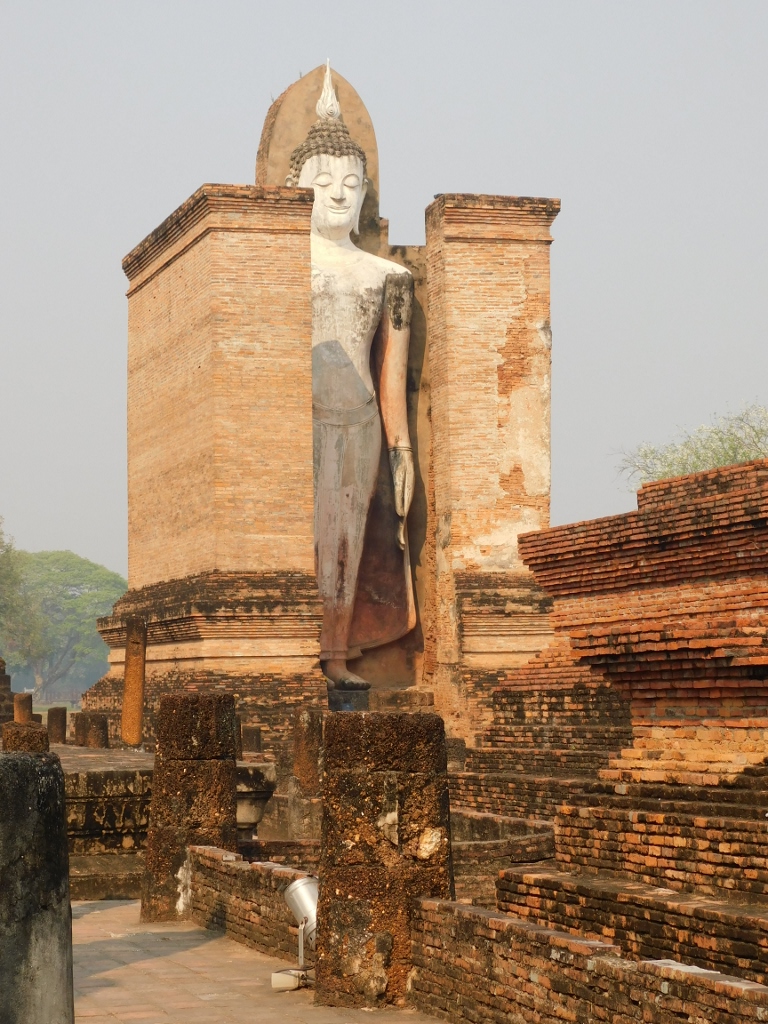 Wat Mahathat, north mondop
Wat Mahathat, north mondop
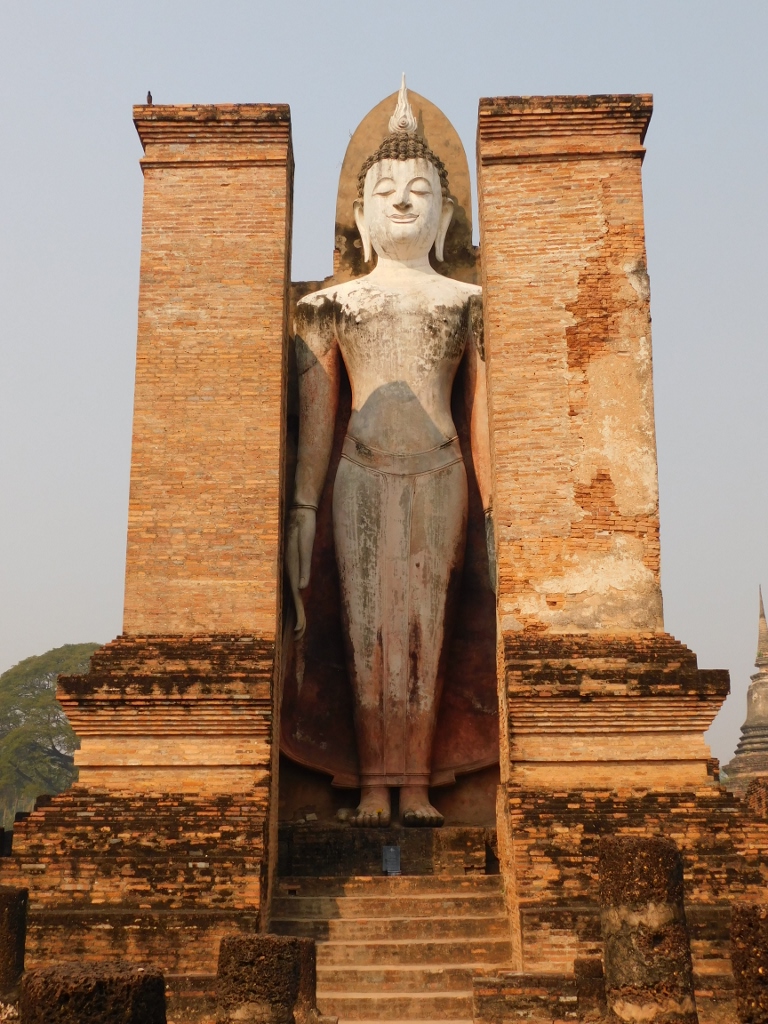 Wat Mahathat, north mondop
Wat Mahathat, north mondop
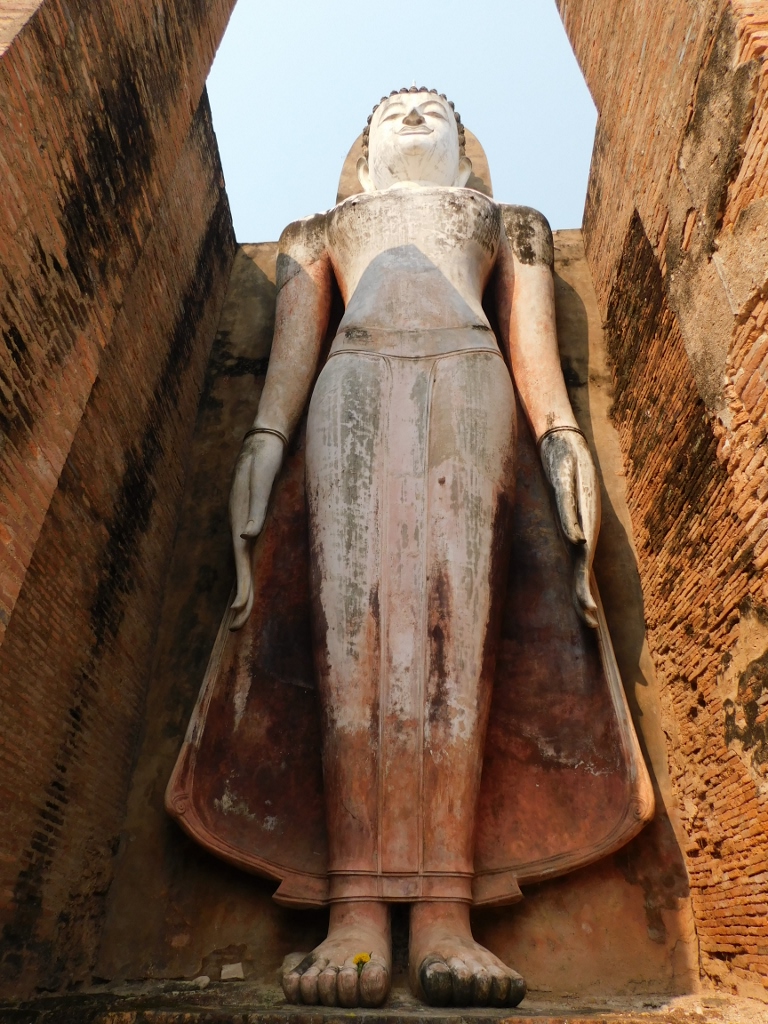 Wat Mahathat, north mondop
Wat Mahathat, north mondop
Then I walked over to the next structure where I first noticed the sema stones, so I concluded that it was an ubosot since these stones are placed around ubosots in order to demarcate the sacred space of the structure.
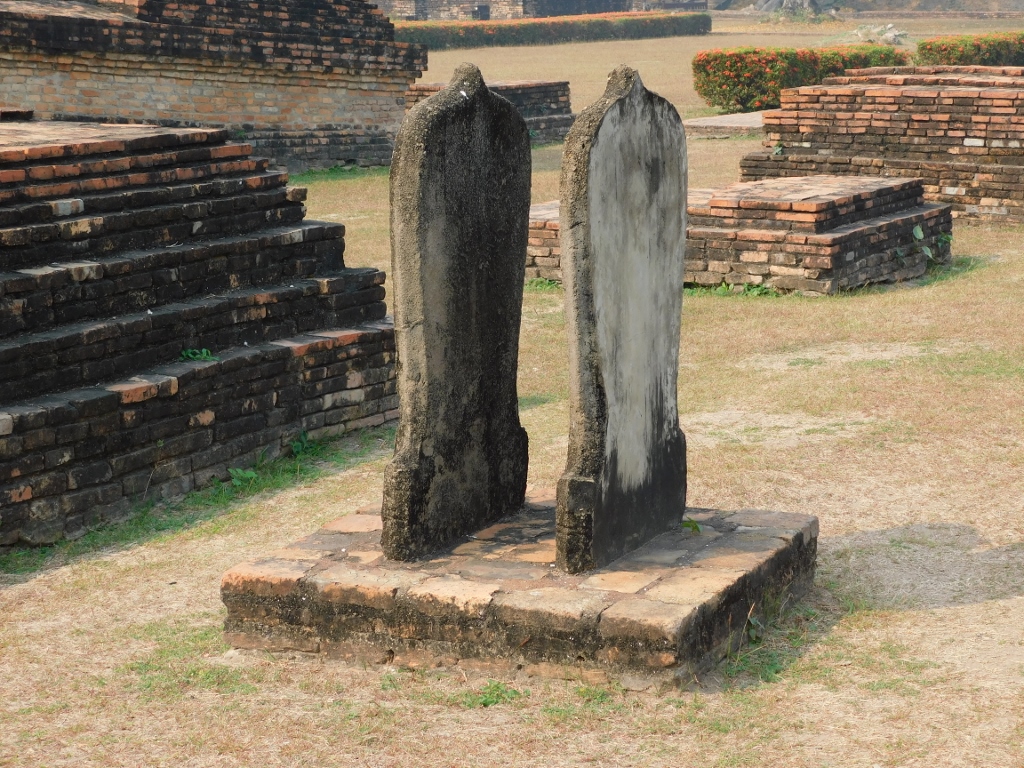 Wat Mahathat, sema stones
Wat Mahathat, sema stones
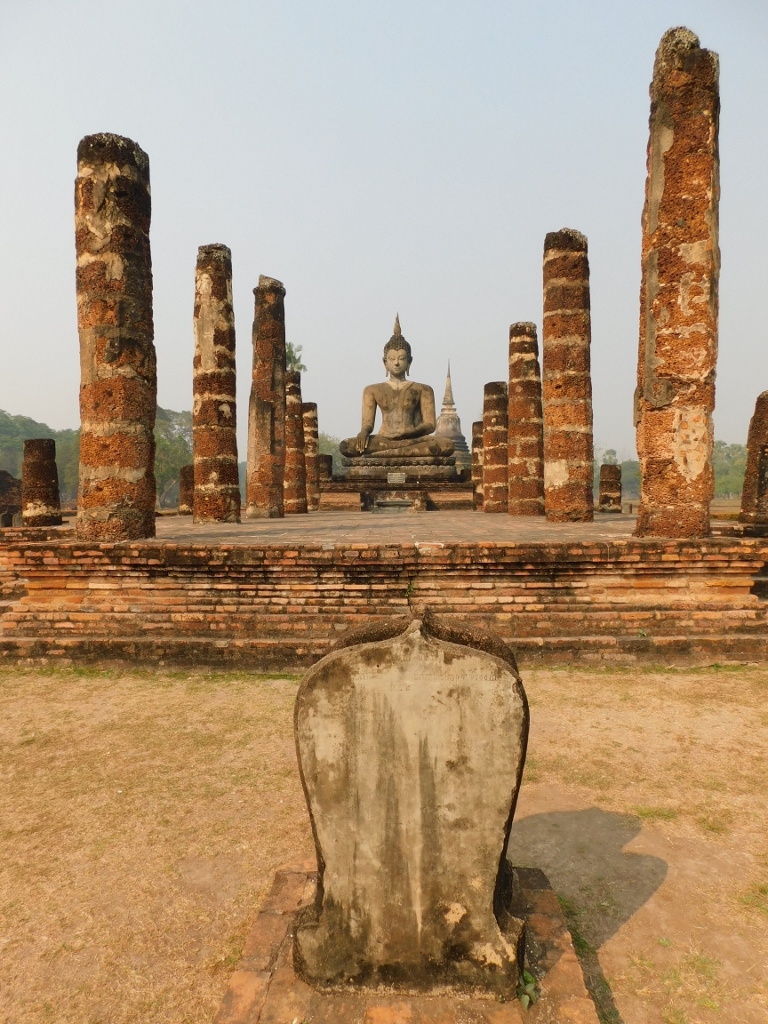 Wat Mahathat, ubosot
Wat Mahathat, ubosot
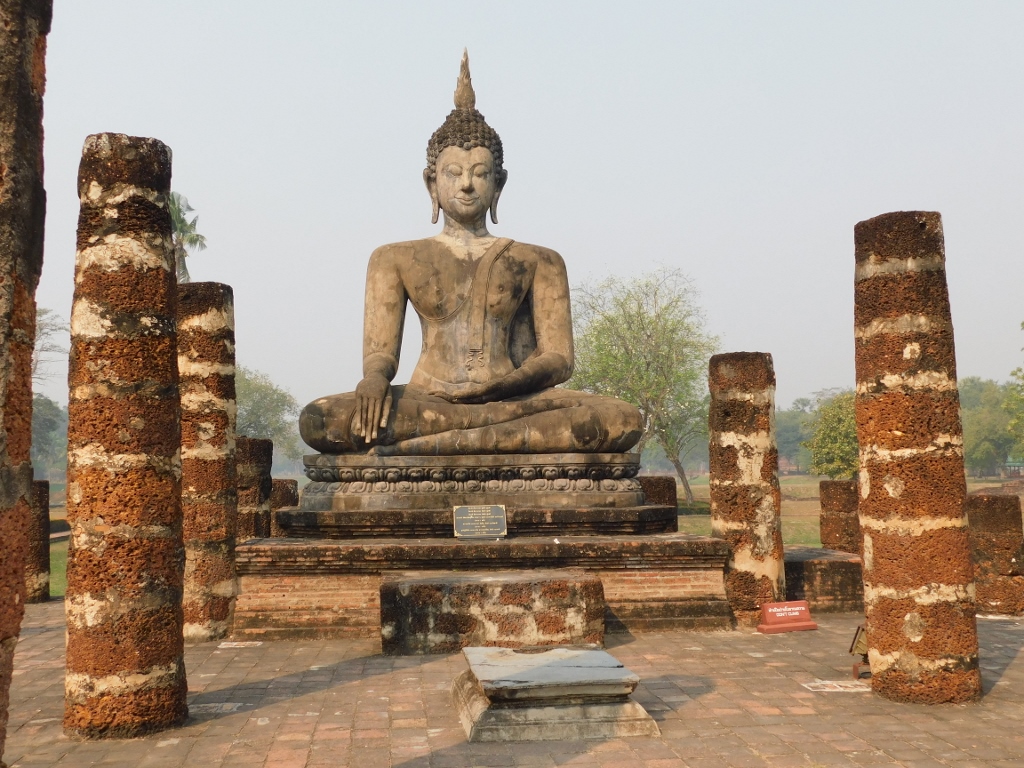 Wat Mahathat, ubosot
Wat Mahathat, ubosot
Behind the ubosot, I took photos of the western parts of the temple and then I proceeded towards the southern section where another mondop with a standing Buddha figure awaited me.
 Wat Mahathat, view at the west section of the temple
Wat Mahathat, view at the west section of the temple
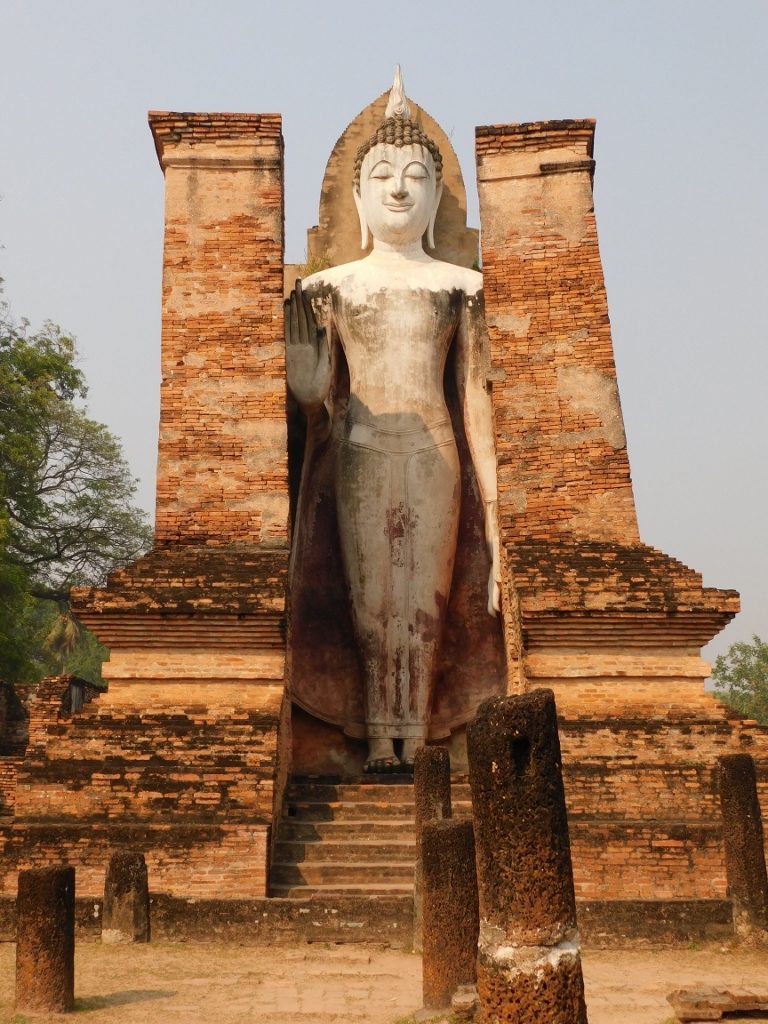 Wat Mahathat, south mondop
Wat Mahathat, south mondop
In the area south of the main chedi, there is a vast array of structures, more than in the northern part, that have survived in varying conditions. Numerous interesting and picturesque details can also be observed.
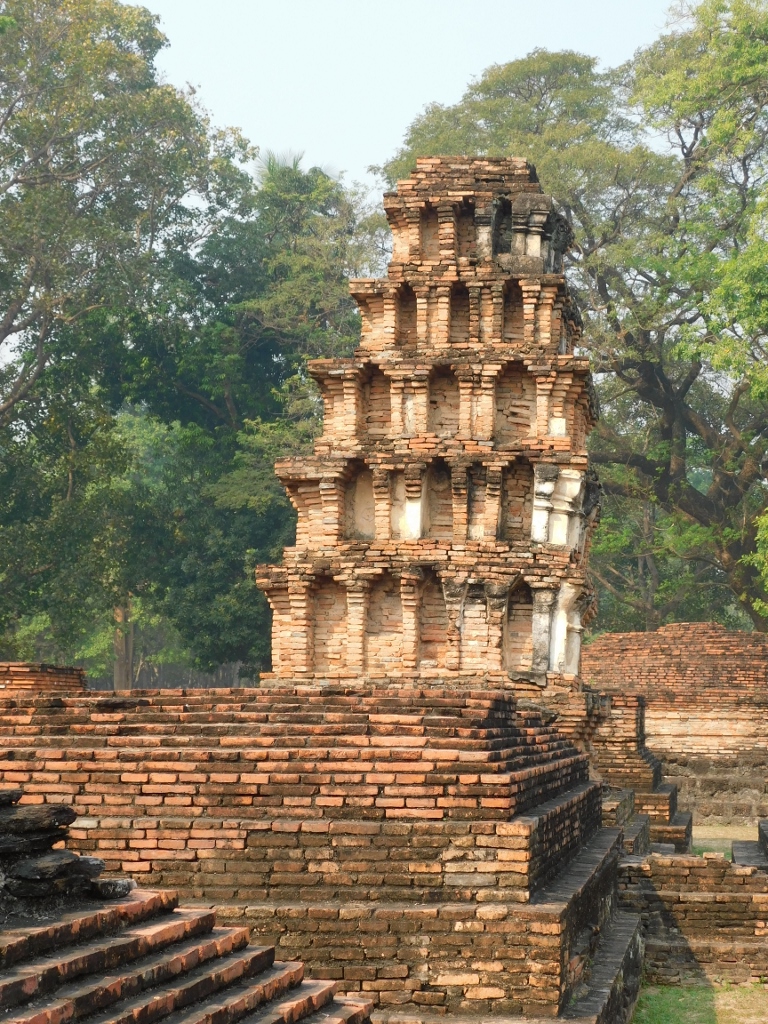 Wat Mahathat, a detail
Wat Mahathat, a detail
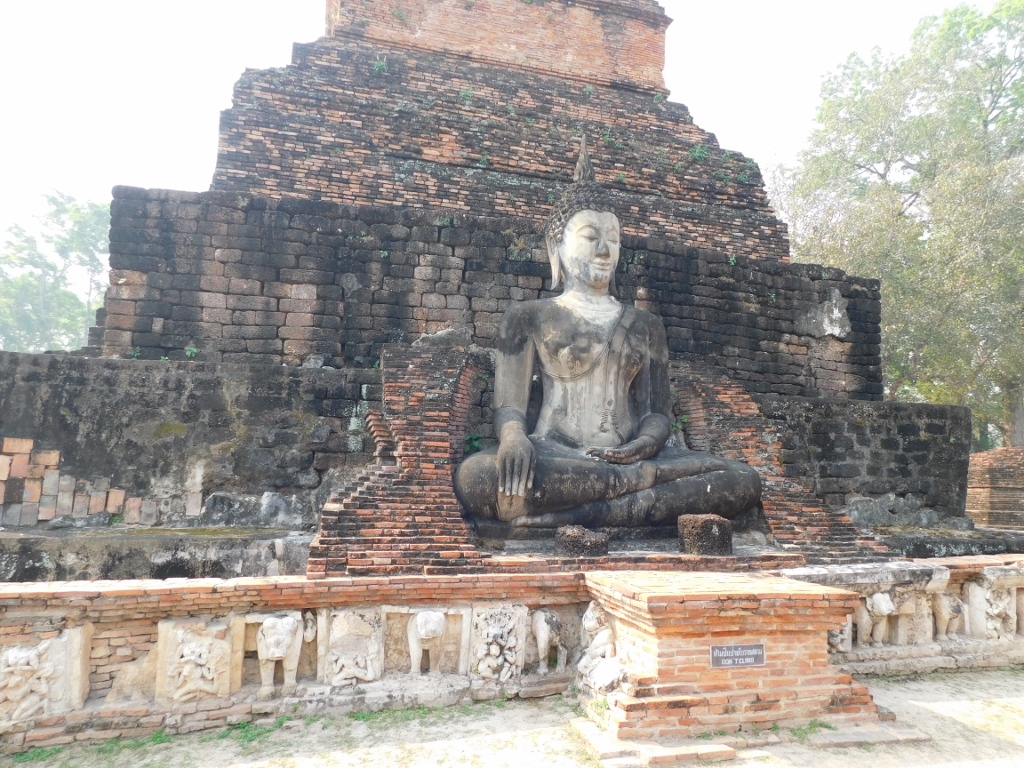 Wat Mahathat, a detail
Wat Mahathat, a detail
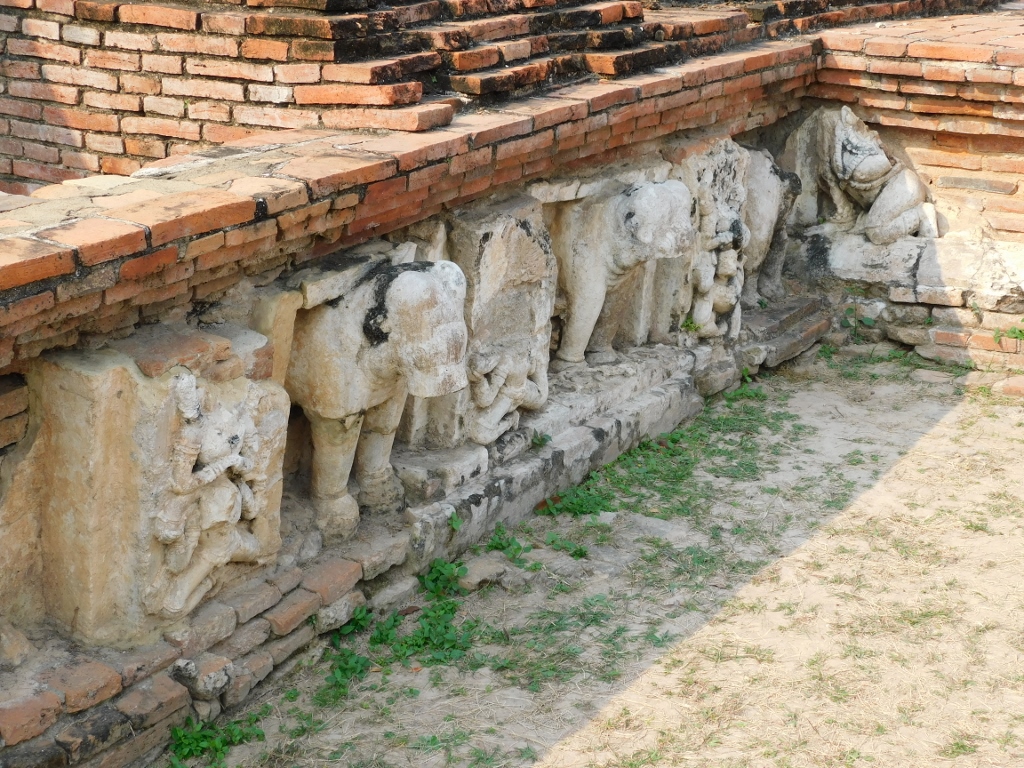 Wat Mahathat, a detail
Wat Mahathat, a detail
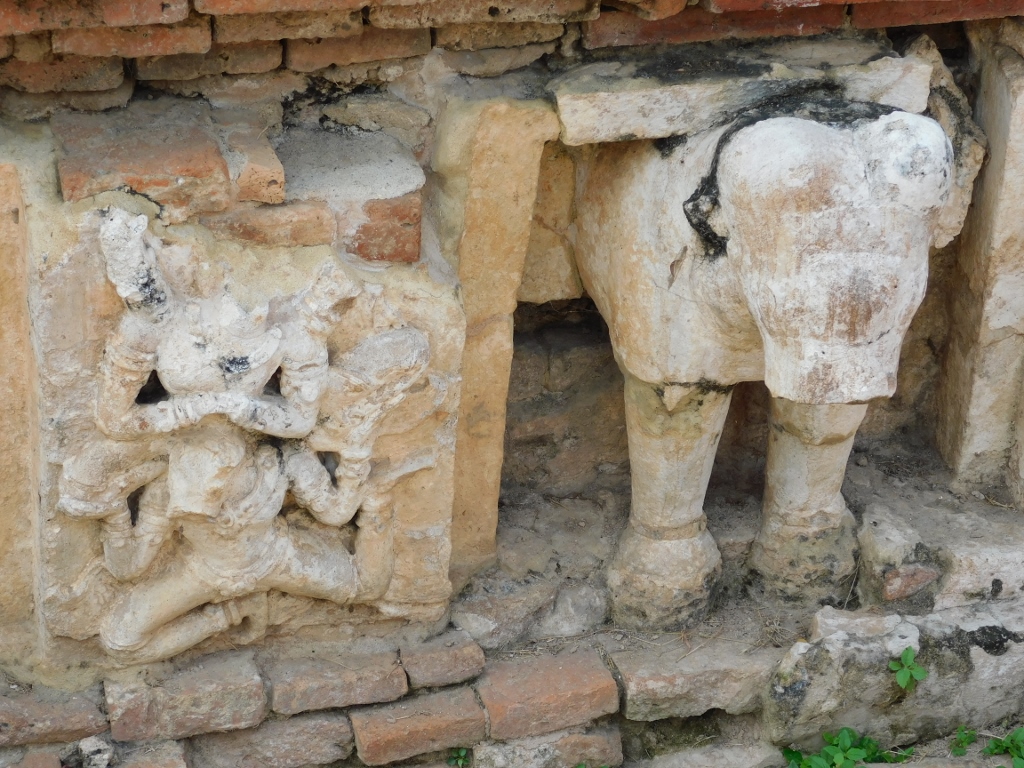 Wat Mahathat, a detail
Wat Mahathat, a detail
Here, I have also concluded the tour of Wat Mahathat, so I took another photo of the southern part, as well as the main chedi, main vihara and main mondop, which were a bit farther away.
 Wat Mahathat, a detail
Wat Mahathat, a detail
Now I was ready to return to my parked bicycle and continue exploring the Sukhothai Historical Park.